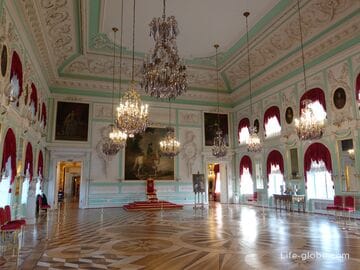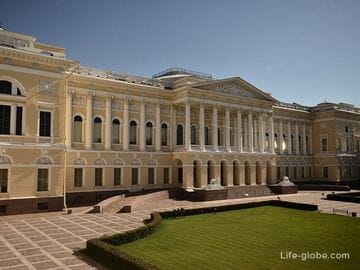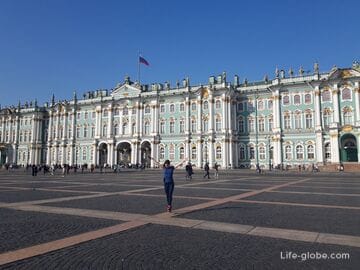The Catherine Palace is one of the largest, most famous and most visited palaces in St. Petersburg and Russia as a whole.
The palace is also known as: The Grand Tsarskoye Selo Palace, the Grand Catherine Palace, the Grand Palace or the Old Palace.
The palace was founded in 1717 by order of the Empress Catherine I (wife of Peter I), after whom it was named.
Over the course of history, the palace has undergone changes - it has become larger and more elegant. It was the official summer residence of the Romanovs. It was badly damaged and looted during the Second World War; it was then restored, including according to drawings, materials, photographs and preserved fragments of decoration.
Today, the Great Catherine Palace has a Baroque style, admires with its size and picturesque decor. The palace is a museum, it is adjacent to the Catherine Park, together with which the palace is a complex of the Catherine Palace and Park ensemble, located in the former Tsarskoye Selo (now the city of Pushkin in St. Petersburg). Learn more about the Catherine Palace...
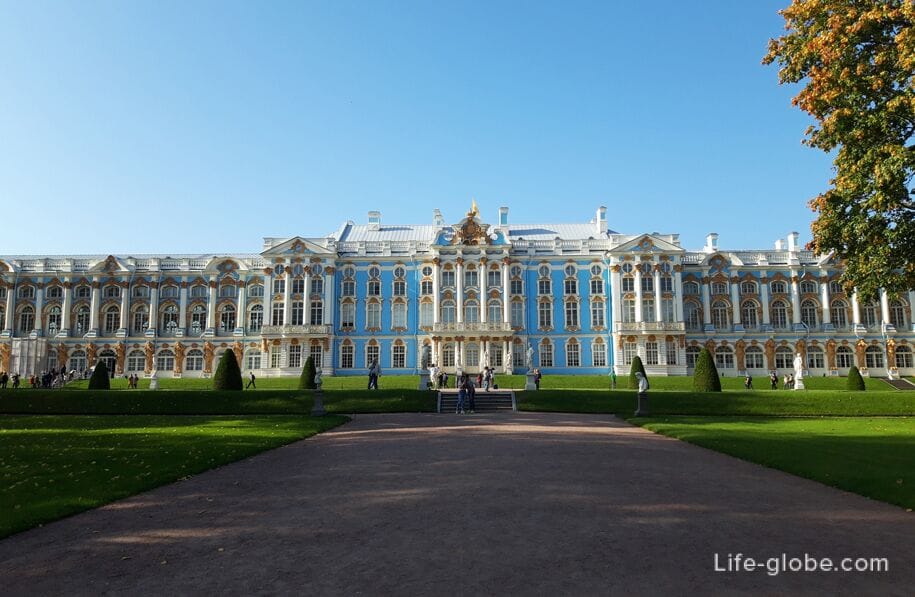
In the palace (for a fee) you can visit the restored rooms-museums: the halls of the Catherine Palace, the palace Church of the Resurrection of Christ and the memorial museum-lyceum. Visiting each of the museums is possible for a fee.
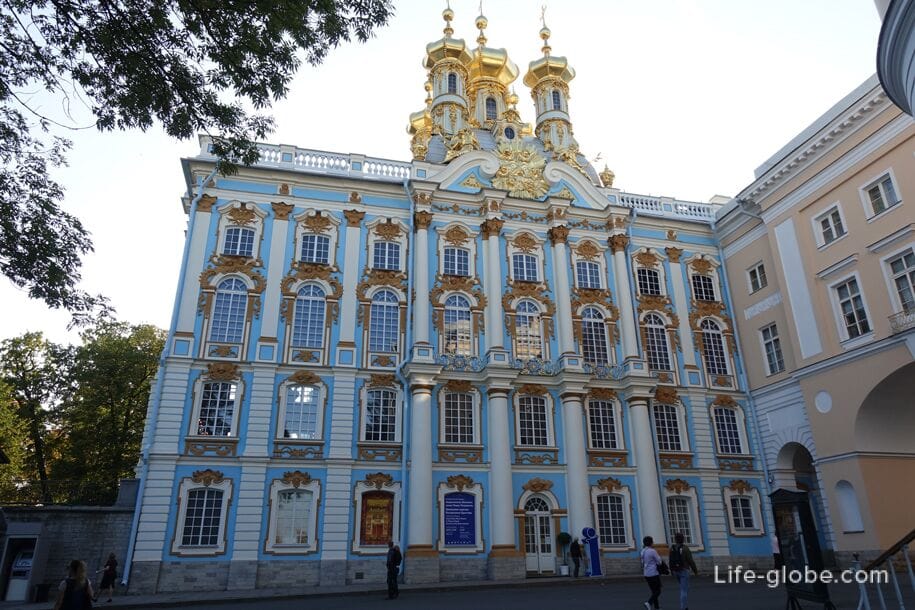
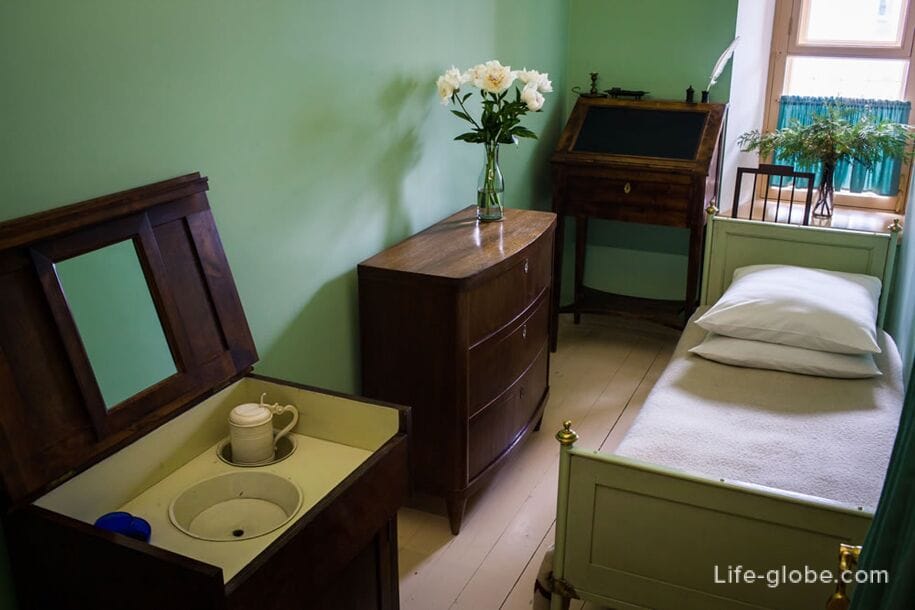
This article will focus on the museum "halls of the Great Catherine Palace", the exposition of which covers more than 300-year history of the outstanding monument and introduces the imperial Romanov family, the work of architects who participated in the construction and decoration of the palace in the 18th and 19th centuries, as well as the achievements of restorers who revived the palace after the Great Patriotic War.
Halls of the Catherine Palace
When visiting the halls of the Catherine Palace, guests, as part of the tour, can walk through the restored halls of the former imperial residence, while learning the history of the palace and see some objects of decorative and applied art, furniture and works of sculpture and painting, dishes, jewelry, etc., located in the halls of the museum-palace.
You can also walk around the palace halls with an audio guide that you can download to your phone, or rent in the lobby (on the first floor) of the palace. On the first floor of the palace there are also: cafes, toilets, cloakrooms, places to relax.
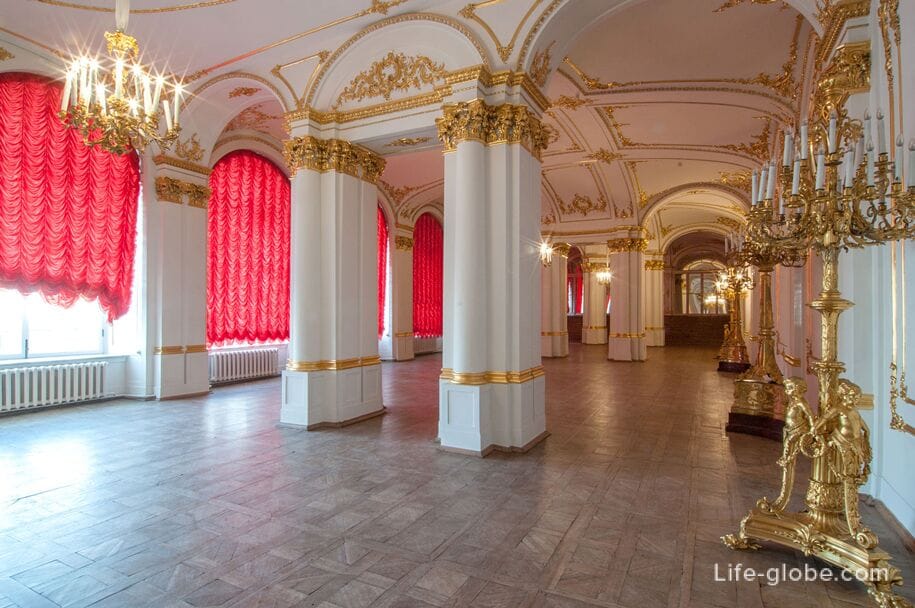
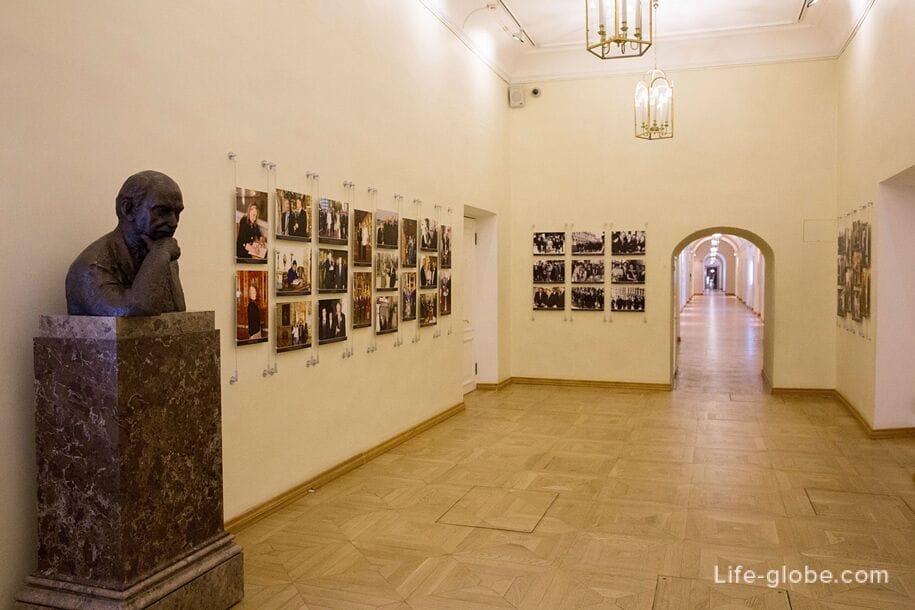
The museum halls of the palace are located on the second floor.
Grand staircase
The grand staircase is located in the center of the palace. It was created under the Empress Catherine II by the architect Ch. Cameron on the site of the Chinese Hall of the Great Tsarskoye Selo Palace. In 1860-1863, the staircase was rebuilt by the architect I. A. Monighetti, who executed it in marble, decided in the Rococo style and decorated it with through-carved balustrades and figured vases.
From the east and west, the staircase is illuminated by windows arranged in three tiers.
White marble steps rise from both sides to the middle platform, from which four marches lead to the second floor, to the main halls of the Catherine Palace.
On the walls of the staircase interior, decorated with stucco ornaments and sculptures, there are decorative vases and dishes of Chinese and Japanese porcelain from the 18th and 19th centuries-in memory of the Chinese Hall that was located here in the middle of the 18th century.
Caryatids frame the doorways. The restored marble sculptures "Sleeping Cupid" and "Waking Cupid", executed by V. P. Brodzsky in 1860, are installed on the stairs.
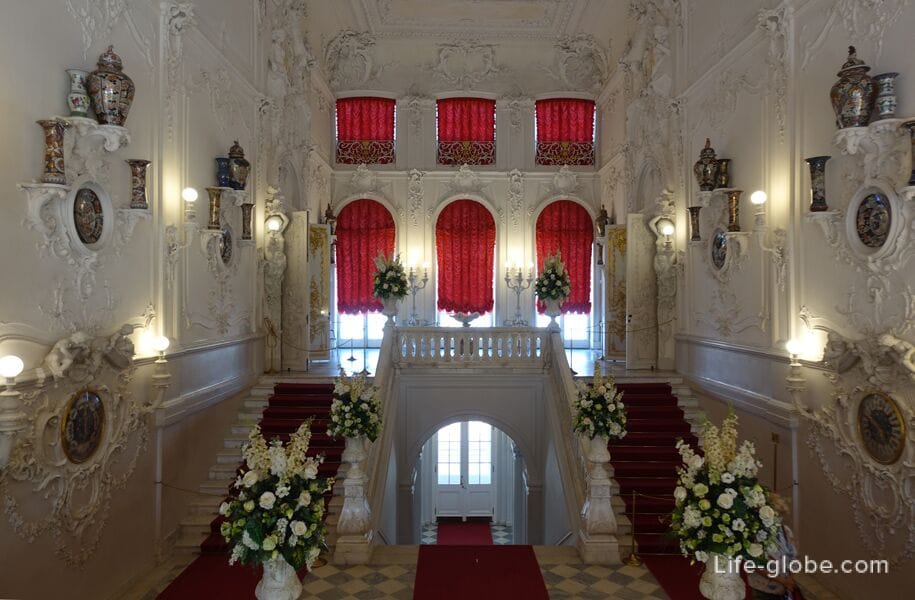
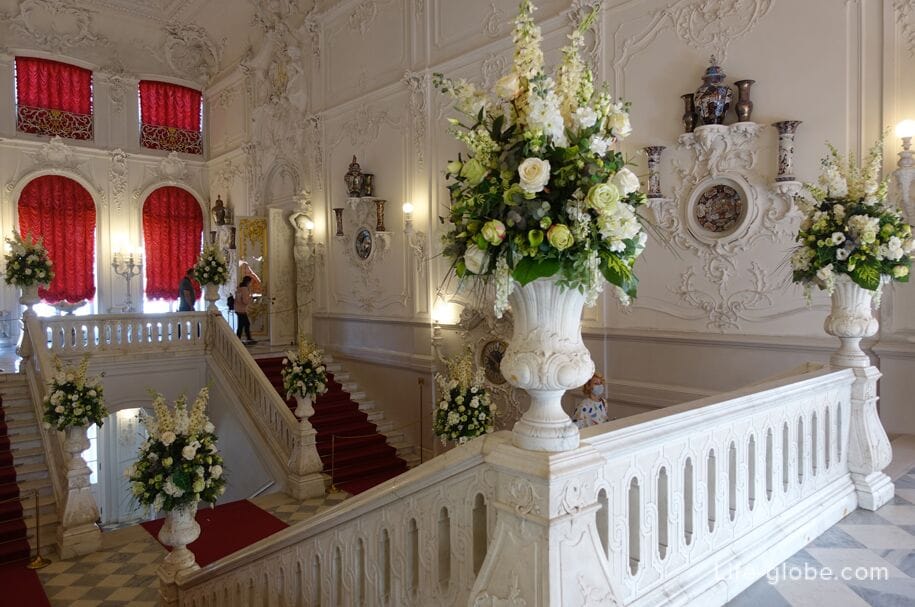

The ceiling of the Grand Staircase is decorated with picturesque plafonds with paintings: "The Court of Paris", painted by the Italian painter C. Maratti and "Jupiter and Callisto" by P. Liberi, which were obtained from the collection The State Hermitage Museum, the composition "Aeneas and Venus" by an unknown Italian artist of the 18th century, located on the western side, was presented to the museum by a resident of Leningrad, A. Tikhomirov.
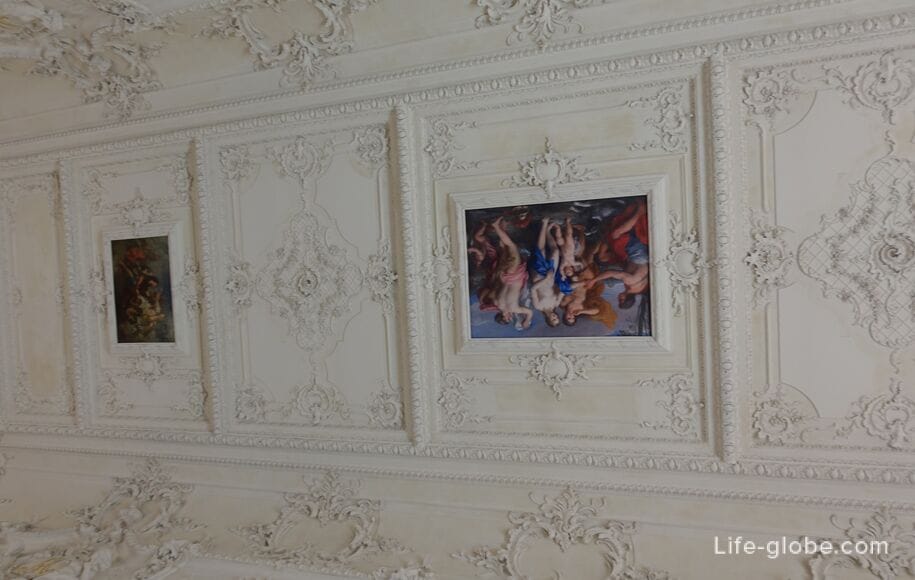
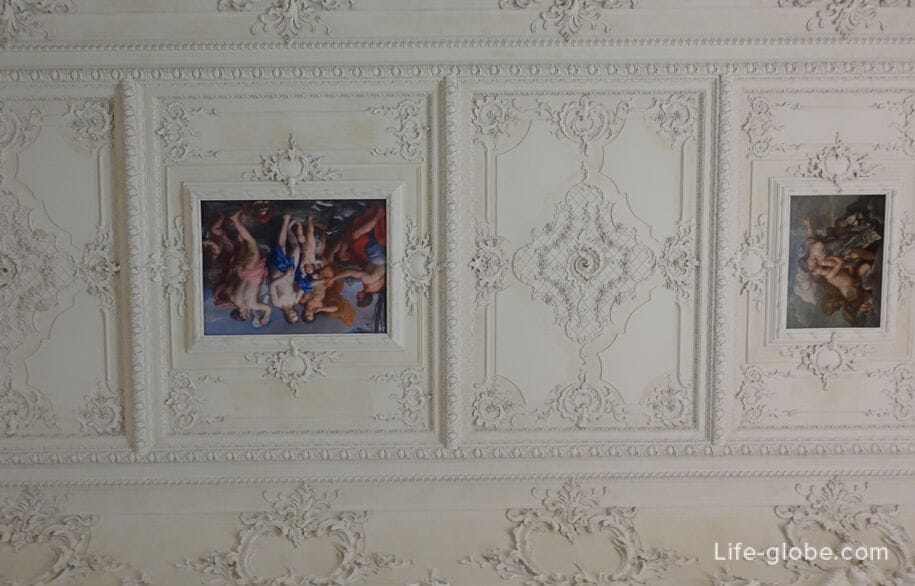
Exhibition halls
To the south of the grand staircase there are two exhibition halls located together with a former Pantry.
In the first hall, one of the elements of the interior decoration of the mid-19th century, preserved during the Great Patriotic War, is presented - a fragment of the paduga with the stucco decoration of the Great Hall of the palace (transition from the plane of the walls to the plafond).
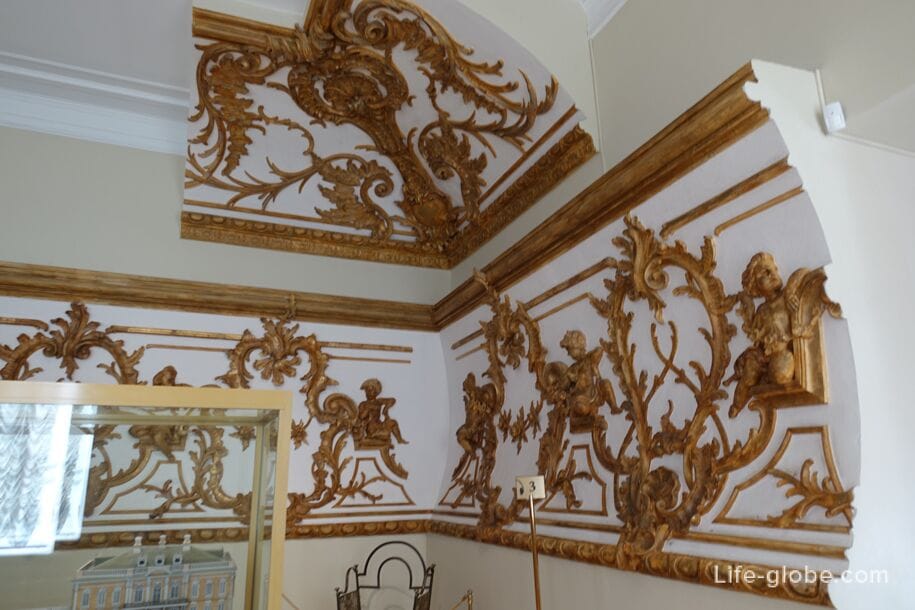
In the center of the hall is a model of the Great Tsarskoye Selo Palace, created in 1744 and reflecting one of the significant stages in the history of the construction of the imperial residence.
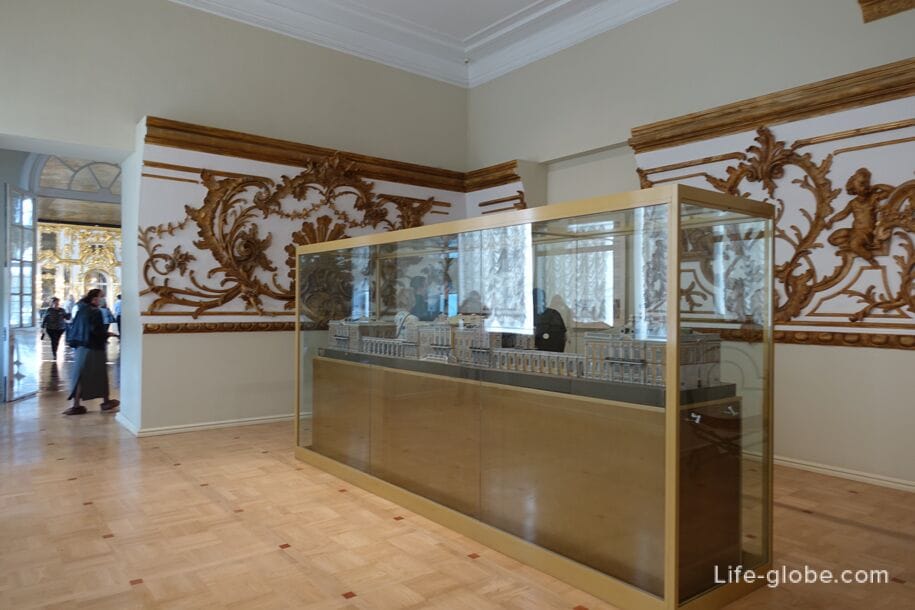

Large Hall (Light gallery)
The Great Hall, which in the 18th century was called the "Light Gallery" - the largest front room of the palace, with an area of more than 800 square meters, which was created by the architect F. Rastrelli in 1752-1756. The hall was intended for official receptions and celebrations, ceremonial dinners, balls and masquerades.
The large windows of the hall overlook both sides of the palace. In the walls between the windows there are mirrors that reflect light and create the illusion of boundless space. Mirrors frame 696 candles.
Sculptural and ornamental carvings with multi-figure compositions cover the walls of the hall in a solid pattern.
The plafond (drawing on the ceiling) represents " An allegorical representation of Science, Art, and Industry."
The floor of the hall consists of stacked parquet made of stained and light oak.
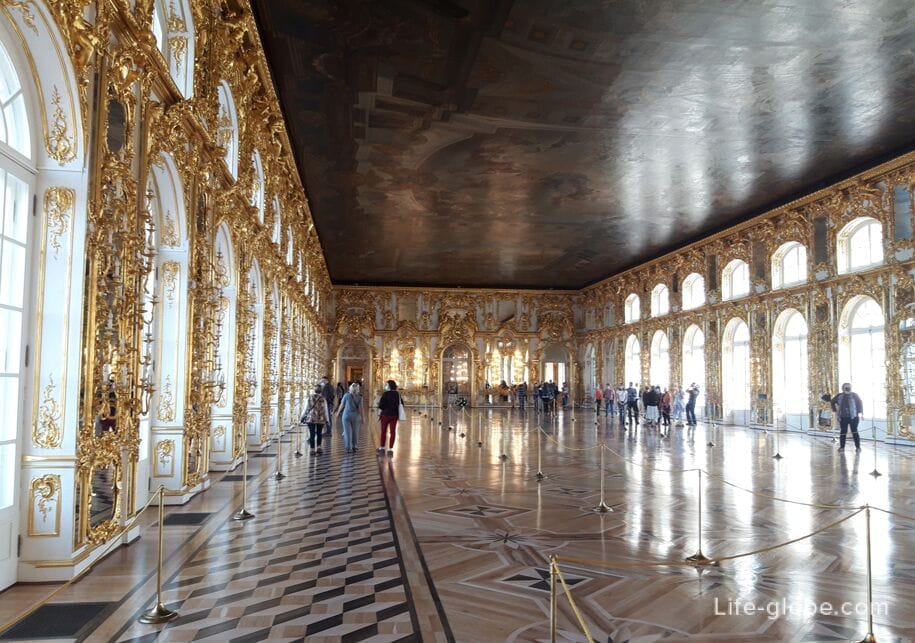
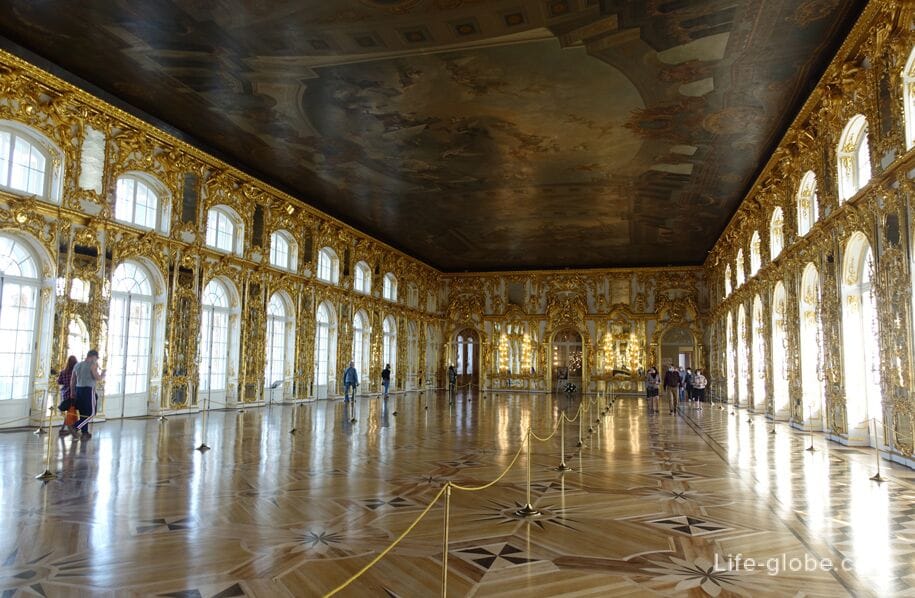

Anti-cameras
Anticamera got its name from the Italian "anticamera" - front, hallway.
These rooms were located in front of the Great Hall and were intended for waiting for receptions and the exit of the Empress. As a result of the reconstruction of the late 18th century, instead of five anti-chambers, three remained.
During large receptions, anti-cameras were also used as living quarters.
In the time of Catherine II, the Third anti-chamber was called a Billiard Room, since it was a billiard table, which then became fashionable and on which the Empress could afford to play a game of "alaguerre" in the evenings (from the French "a la guerre" - in the war; a game of billiards with two balls for two or more players).
The main elements of the antique chambers are wooden gilded carvings, three-dimensional sculptures, ceilings with large picturesque plafonds and geometric patterns of parquet made of precious wood.
One of the anti-chambers has fluted columns and four large marble fireplaces.
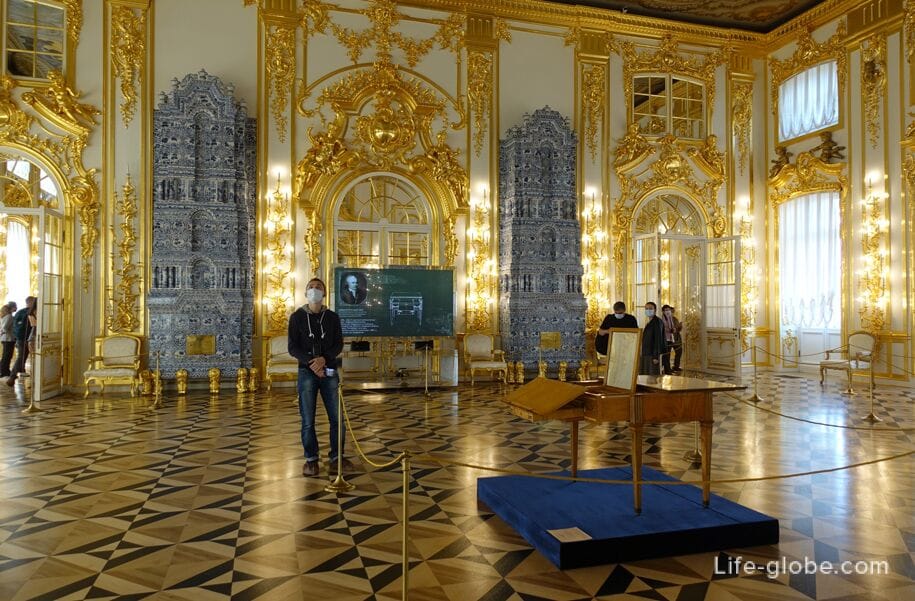
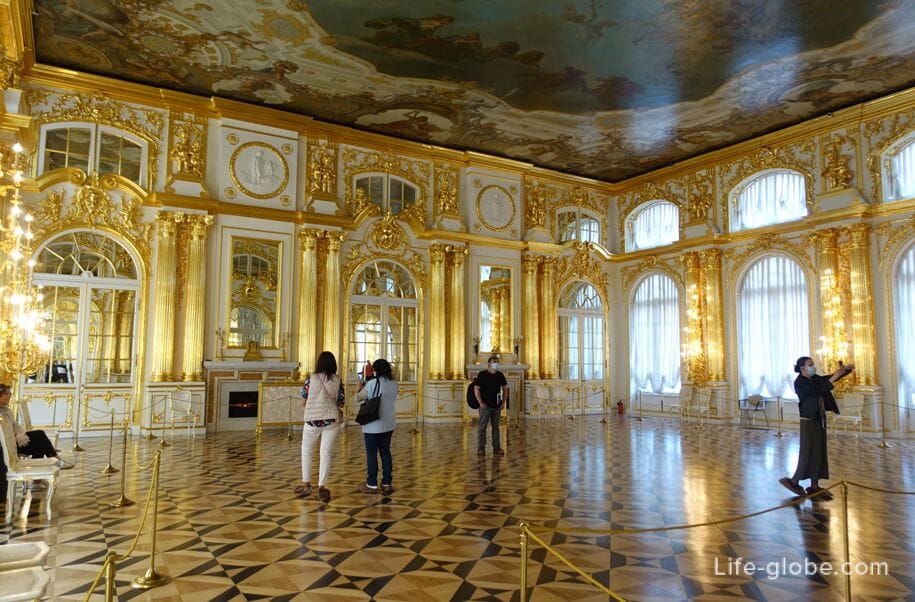
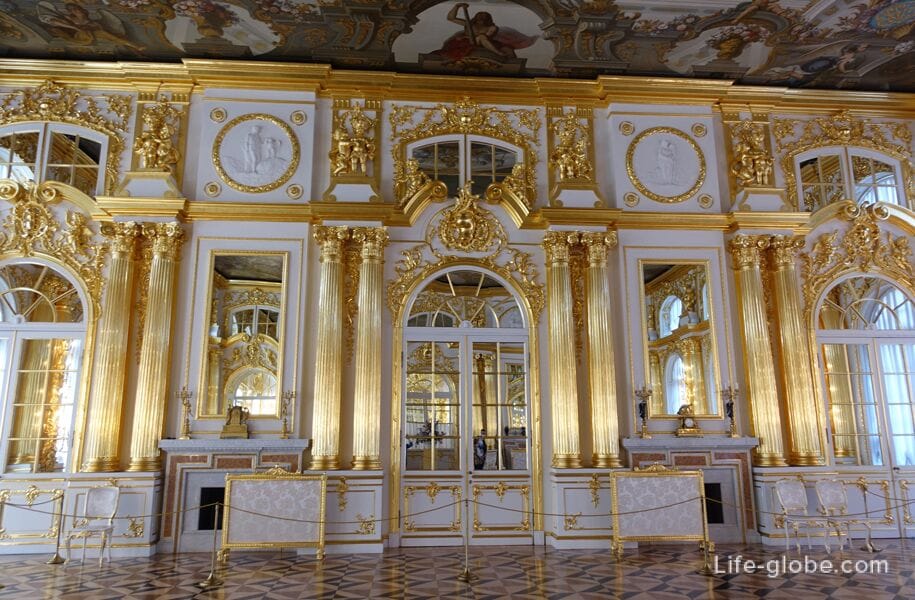
The subjects of the plafonds are devoted to ancient mythology: in the First and Second anti-chambers it is "The Triumph of Bacchus and Ariadne", in the Third - "Olympus".
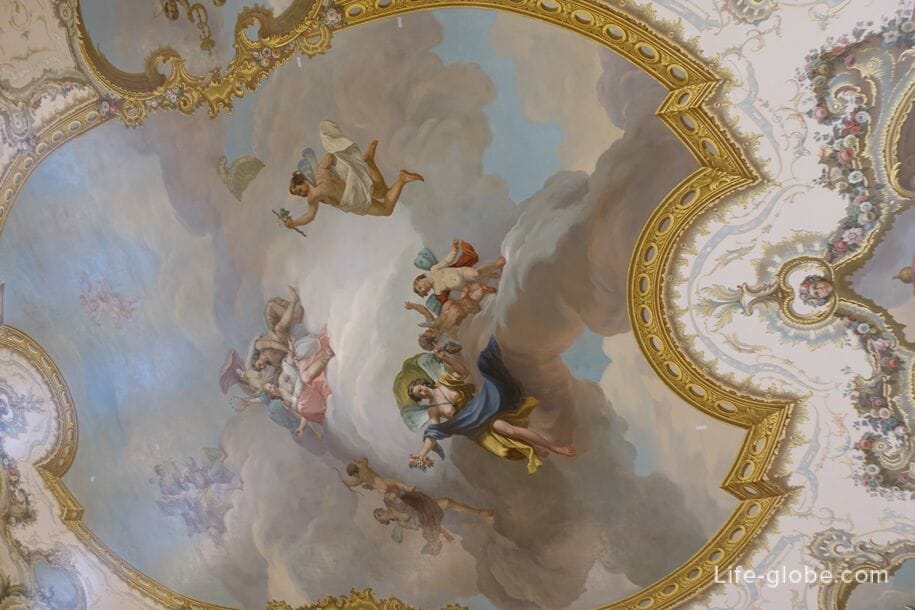
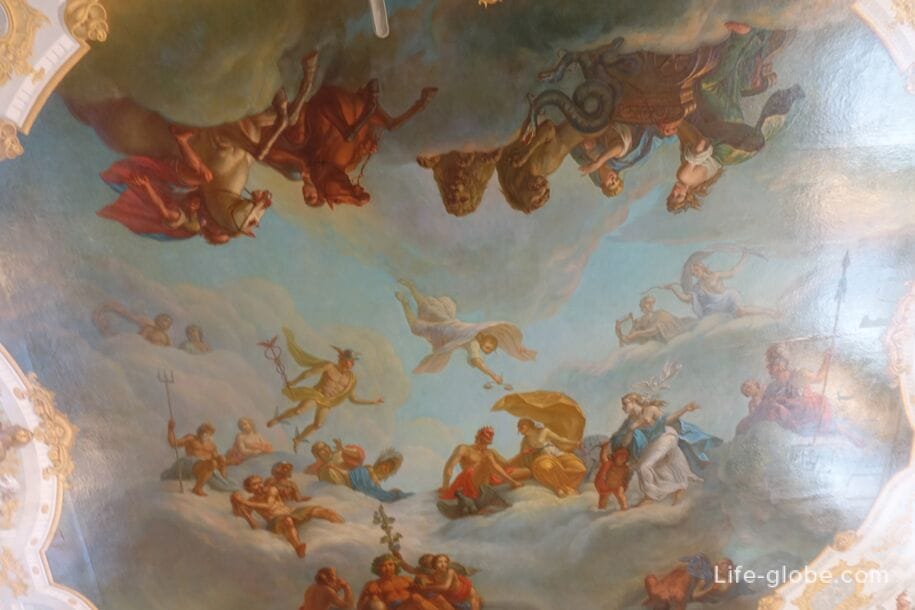
Today, items from the museum's collection are displayed in these rooms. For example:
- family silver of a noble family;
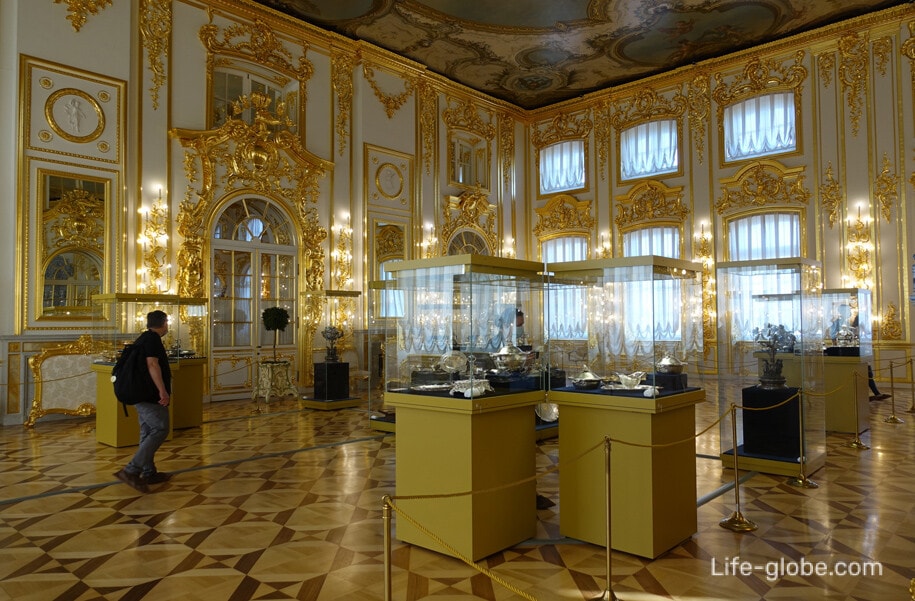
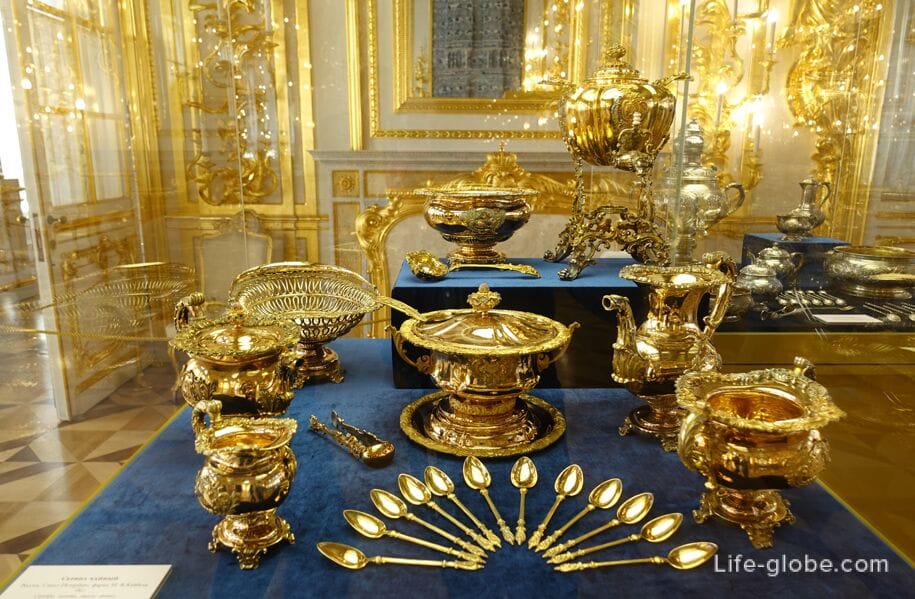
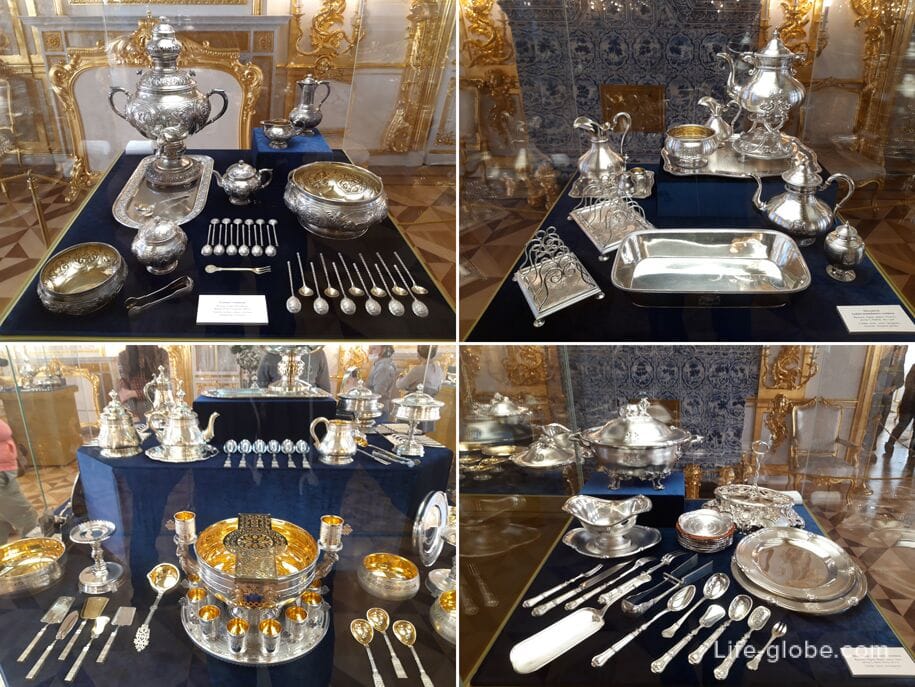
- the table is multifunctional. Neuwid, David Roentgen's workshop. 1783-1784. Base-oak, veneered-palm; brass, gilded bronze. Collection of the Karisalov family.
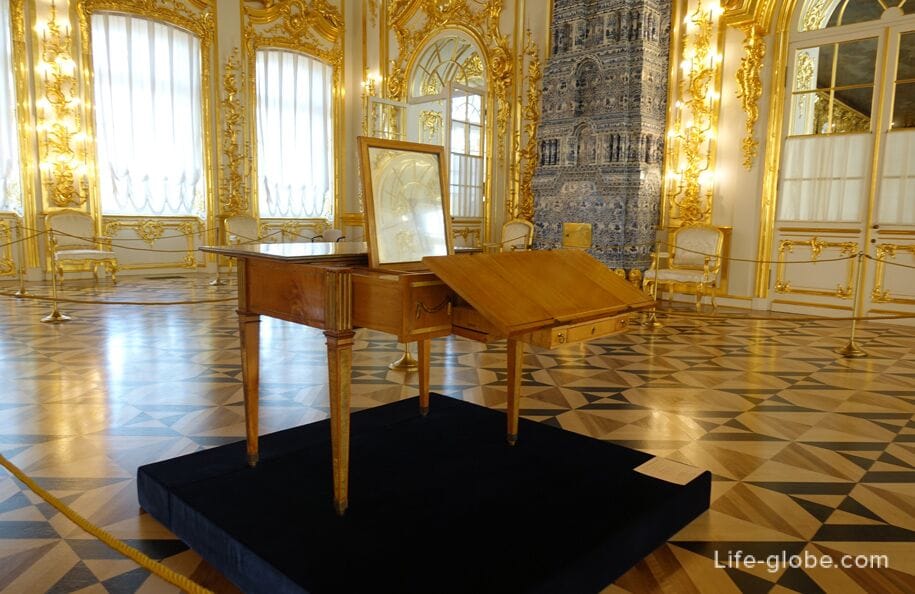
Arabesque Hall
The Arabesque hall was built at the end of the 18th century on the site of one of the anti-chambers.
This is one of the most spectacular grand halls of the palace, created for the Empress Catherine II.
The hall was Catherine's private chambers, which also occupied the premises in the wing attached to the palace, at the request of Catherine II in 1779-1780, later called the Zubovsky wing.
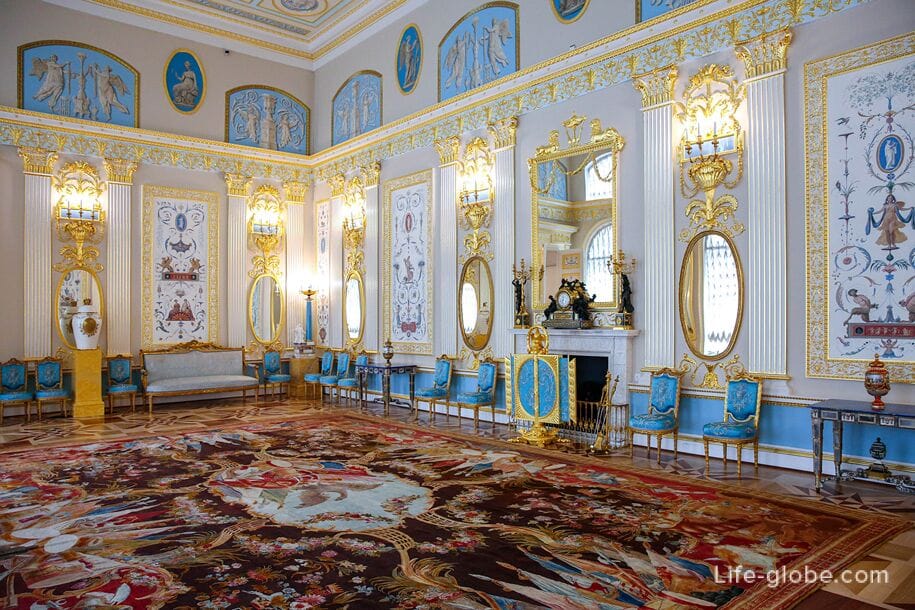
Lyon Hall
The Lyon Hall or "Room of the Lyon Battles", as well as the Arabesque Hall, was built at the end of the 18th century on the site of one of the anti-chambers and was one of the personal chambers of the Empress Catherine II.
The hall had a unique interior and was designed by architect Charles Cameron in 1781-1783 in the classical style. Subsequently, the appearance of the hall changed.
Of the 32 items of lapis lazuli furniture of the Lyon Chamber during the Great Patriotic War, wall mirrors with consoles and a two-tier jardiniere for indoor flowers were lost. The remaining 27 items now belong to a unique part of the museum's collection and are displayed in the restored Lyon Hall.
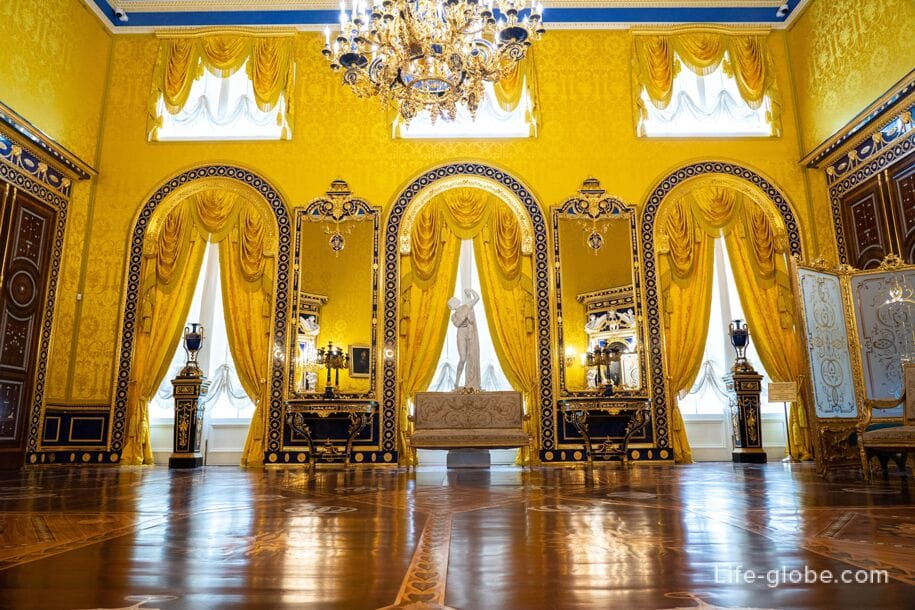
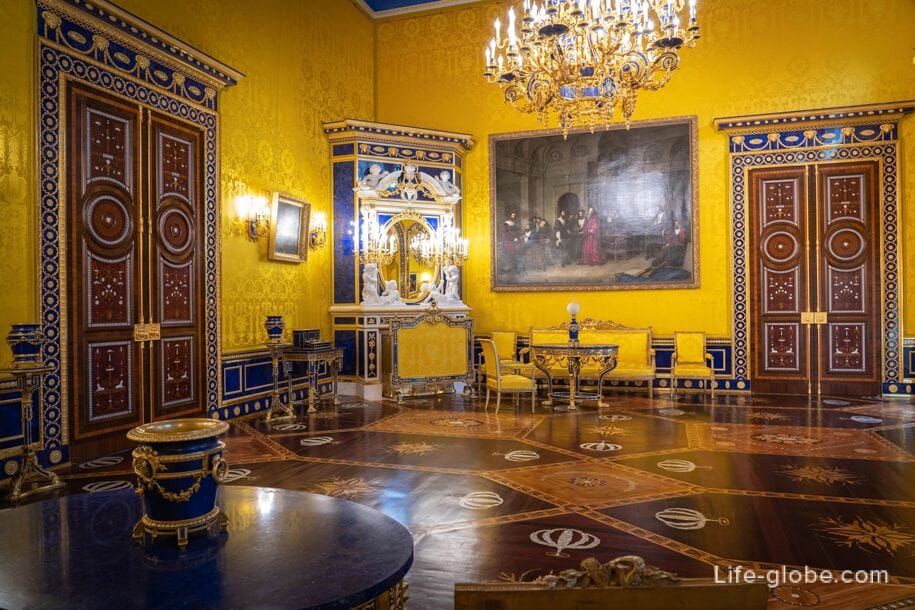
Zubovsky wing
The wing, named "Zubovsky" - after one of the favorites of the Empress Catherine II, was attached to the Great Tsarskoye Selo Palace in 1779-1785, designed by the architect Yu. M. Felten.
The interior of the wing was designed and finished by C. Cameron and D. Quarenghi.
The wing is connected to the Cold Bath Pavilion with Hanging Gardens, which is part of the Cameron Baths ensemble. Learn more about the Cameron Baths Ensemble…
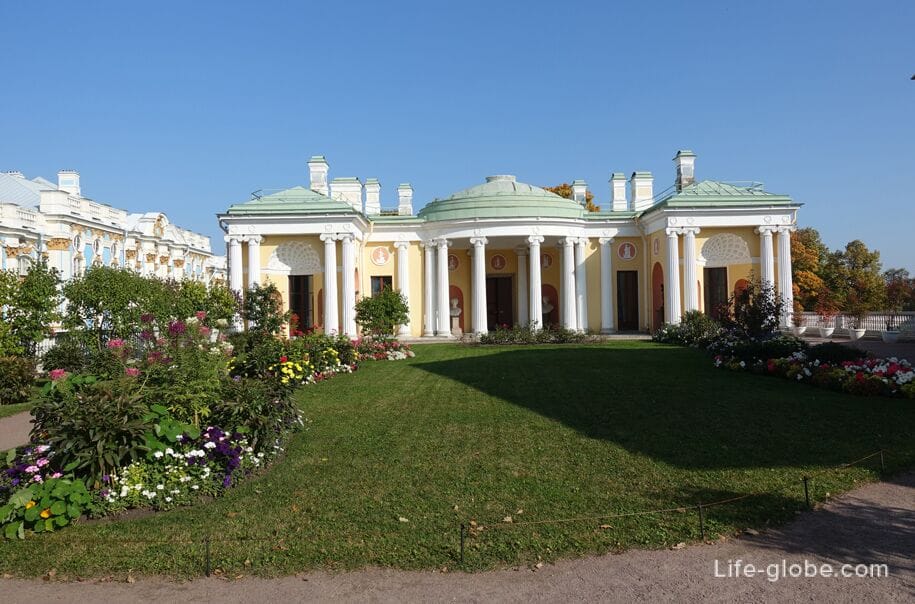
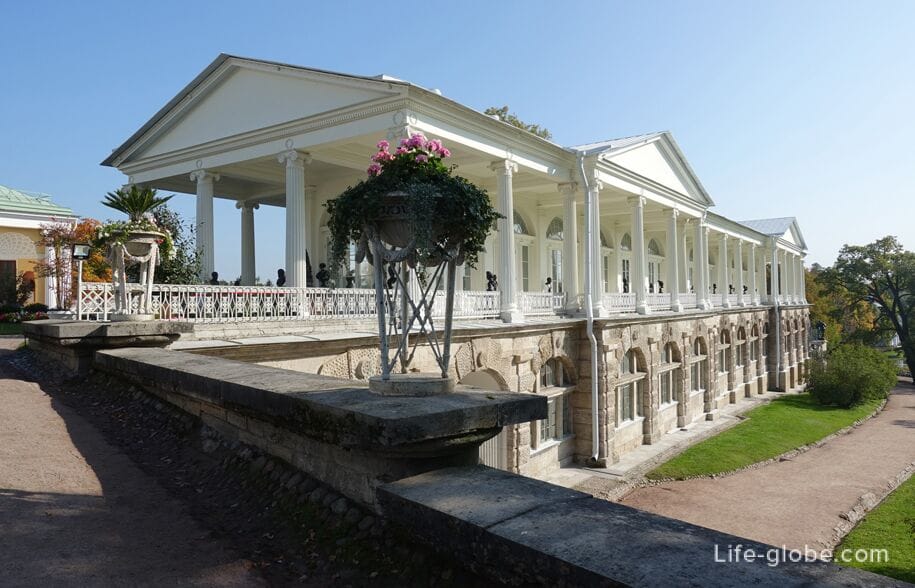
The rooms on the second floor of the wing formed the private half of the Empress and included the Domed Hall, the Chinese Hall, the Silver Study, the Bedchamber, the Blue Study (Snuffbox), the Mirror Study, the Raphael Room, the Kammerungfer and the Lavatory.
The premises of the lower floor of the Zubovsky wing were intended for the favorites: here G. A. Potemkin, A. D. Lanskoy, A. M. Dmitriev-Mamonov and P. A. Zubov were alternately placed.
Subsequently, this part of the palace was occupied by relatives and close associates of the imperial family, as well as the apartments of Emperor Alexander II.
Now the rooms on the first floor of the wing are used for temporary exhibitions.
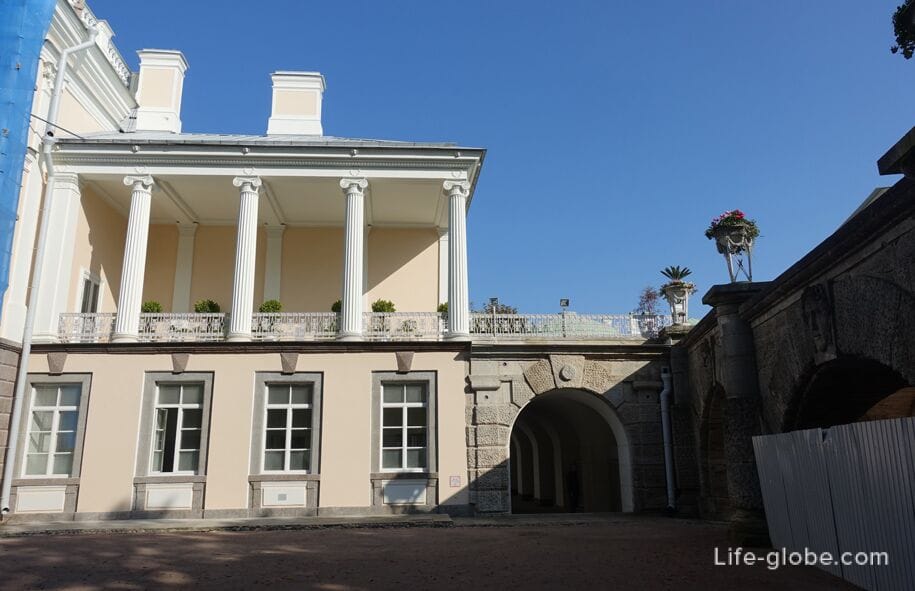
Cavalier dining room
On the north side of the Great Hall of the palace is the Cavalier Dining Room, created by the project of F. Rastrelli.
After the carvings were silvered during the renovation of the hall in the 1860s, the hall was named the Silver Dining Room. This interior lasted until the war. During the post-war restoration, the dining room again received a gilded decoration, conceived by the court architect Elizabeth Petrovna.
Since the size of the room is not large, mirrors and false mirror windows are placed on the walls, which makes the hall more spacious and brighter. The interior design is typical of the Baroque style-it is dominated by gilded carved ornaments of stylized flowers and shells; gilded compositions above the doors-desudeports.
In the center of the ceiling is placed a ceiling lamp of an unknown Russian master of the mid-18th century on the plot of the ancient myth of the sun god Helios and the goddess of the morning dawn Eos (from the funds State Russian Museum). Helios and Eos are depicted surrounded by figures representing the seasons.

The compositional center of the Cavalier Dining room is the tables on which items of "Order" sets are presented, decorated with signs and ribbons of Russian orders, made in 1777-1785 at the first private porcelain factory in Russia by F. Gardner.
The sets decorated the tables on the days of solemn holidays dedicated to the patrons of the most honorable domestic awards - the Orders of St. Andrew, St. George, St. Alexander Nevsky and St. Vladimir.
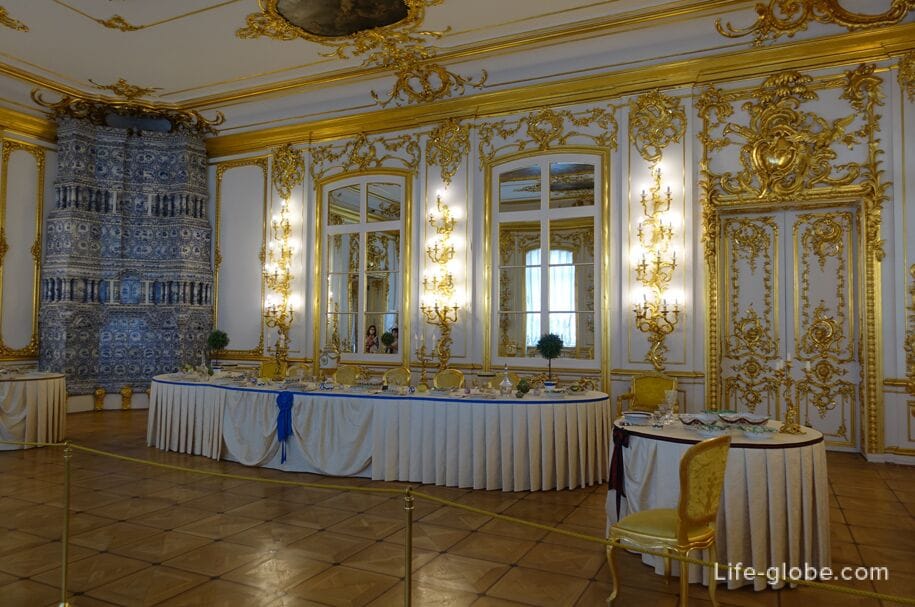


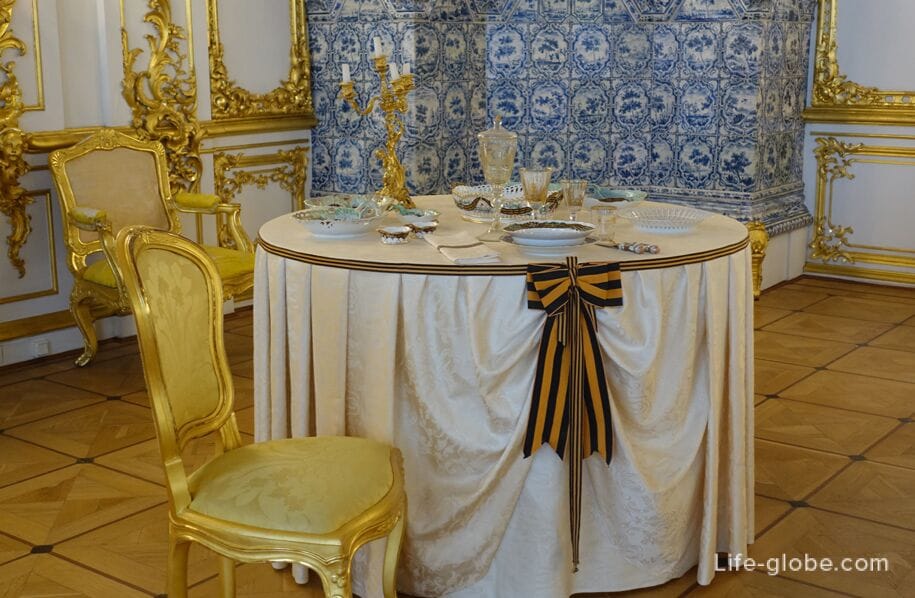
White Formal Dining Room
The White State Dining Room is located on the north side of the grand staircase and was once intended for ceremonial dinners and "evening meals" of the empress in a narrow circle of her entourage.
The walls of the hall are decorated with still lifes by I.-F. Groot-part of a large cycle created by the court painter in the 1740s for the Tsarskoye Selo pavilion of Montbijou, which is now not preserved. Also striking are the large stoves.
The furniture of the dining room is made up of carved gilded consoles and chairs, both authentic and made according to the samples of the mid-18th century.
In the center of the hall there is an oval table with a service made at the Meissen Porcelain Manufactory. This service was listed in the palace storerooms already in the Elizabethan era and decorated the state tables during the grand dinners of the empress.
According to the tradition of the 18th century, the table is covered with tablecloths with complex draperies, decorated with flower garlands.
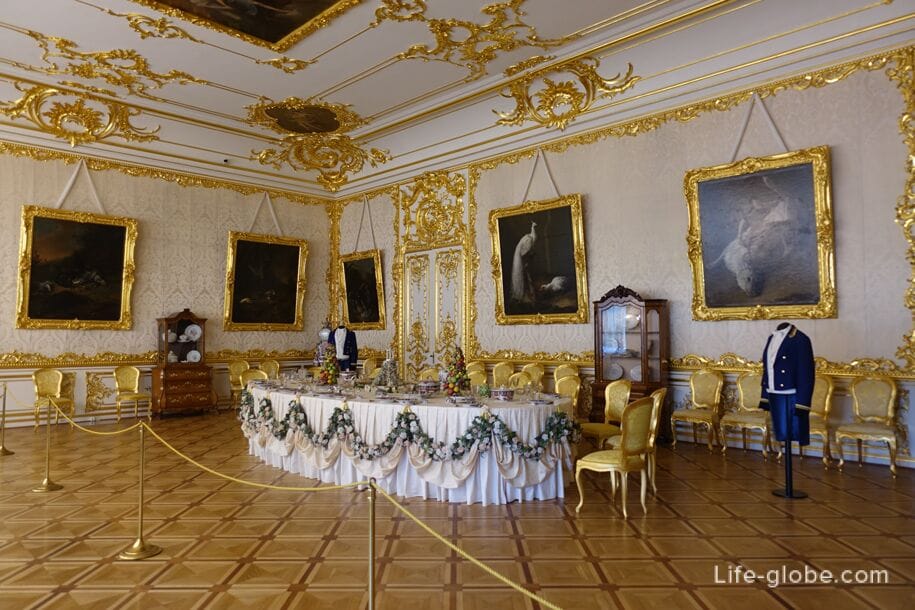


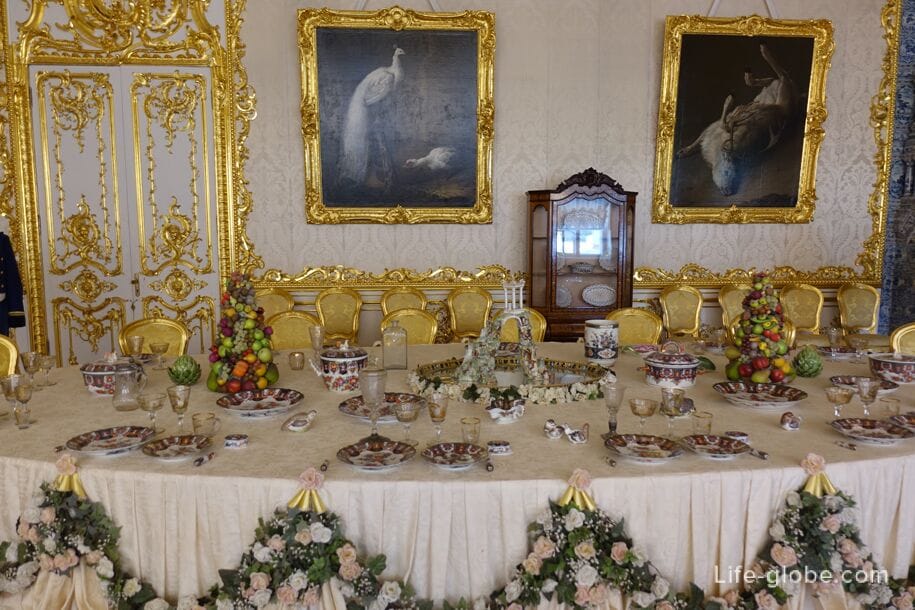
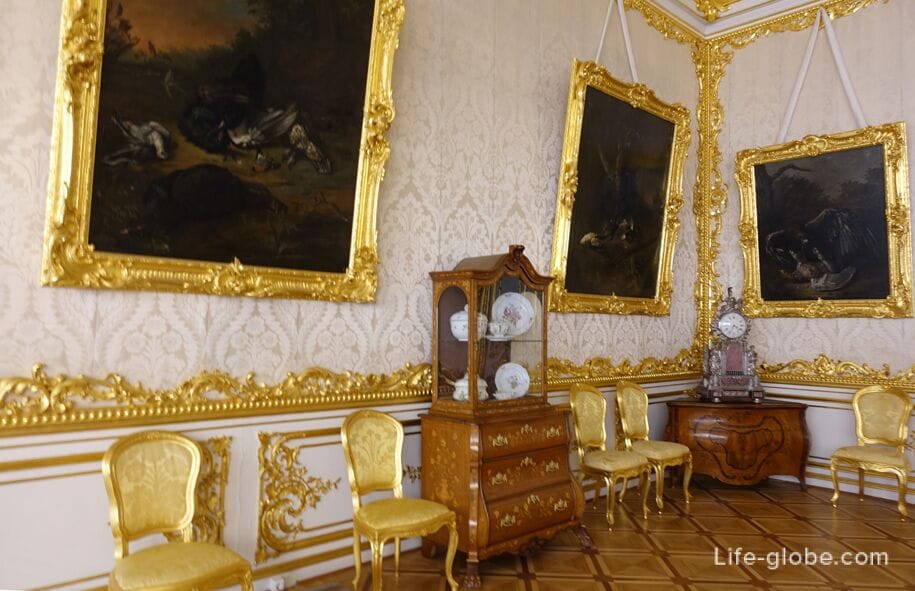
On the consoles between the windows of the hall there are decorative aroma vases, produced in the same way as the service in Meissen.
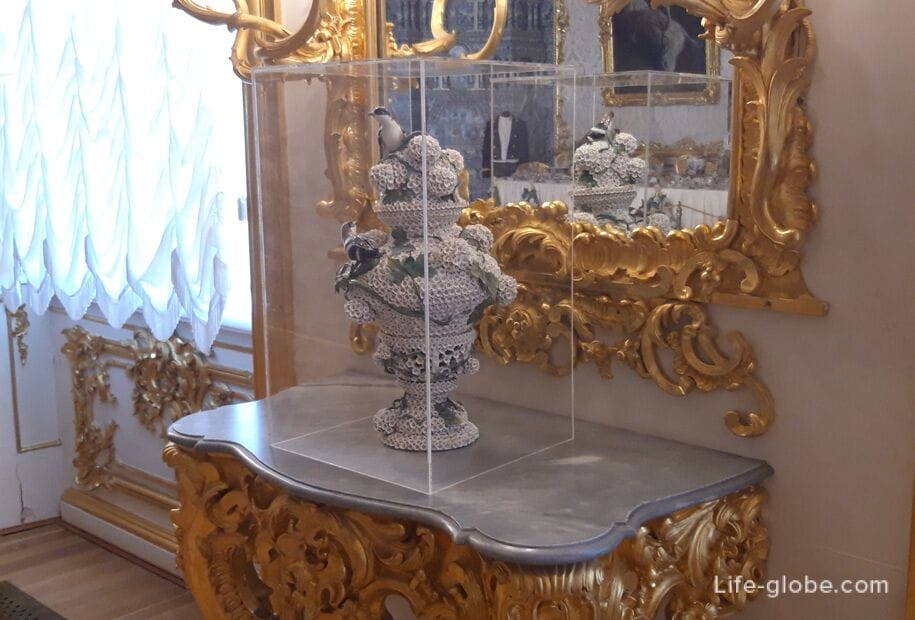
The ceiling of the hall is "The Triumph of Apollo". A copy of the 19th century painting by G. Reni.

Crimson and Green pillars
The Crimson and Green Pillars are two small halls located one behind the other.
The halls are decorated with transparent glass pilasters - "pillars", with crimson and green foil placed under the glass, which gave the names to the rooms.
In Malinovaya Stolbovaya, you will notice the stove, whose tiles are decorated with scenes with characters in costumes of the 18th century, and the picturesque plafond "The Mercy of Alexander the Great" by an unknown Italian painter of the late 17th century.


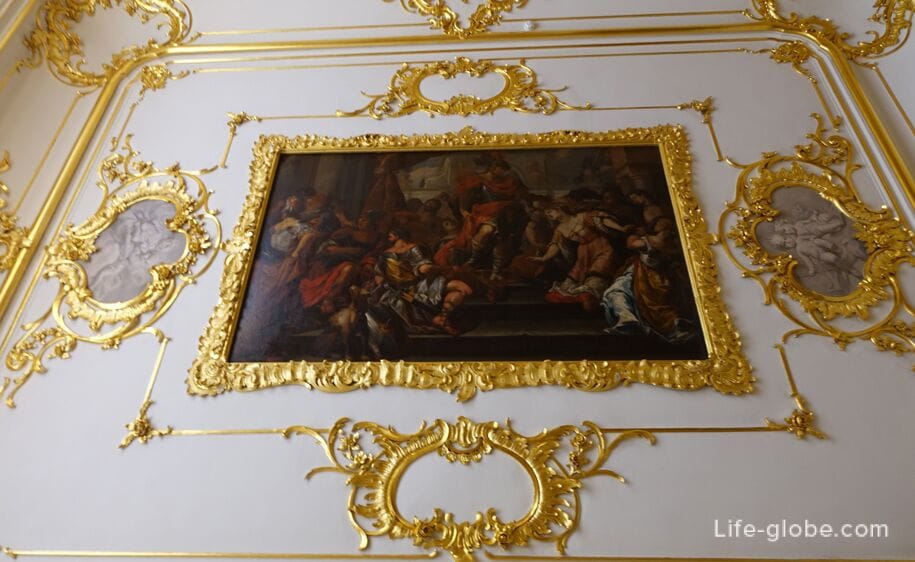
In the center of the hall is a card table with a unique chess set of Chinese work of the 18th century. The board is inlaid with mother-of-pearl plates, the carved figures are made of bone.
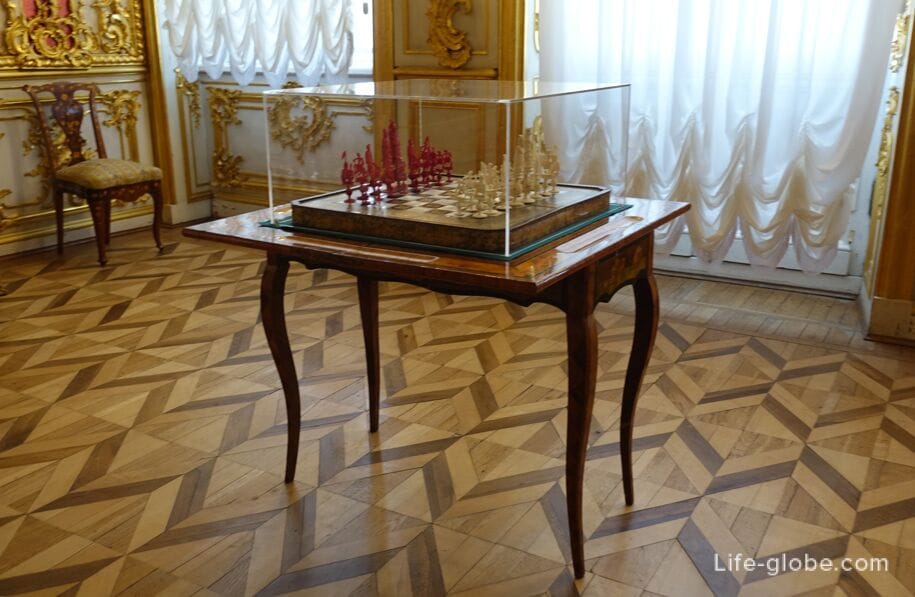
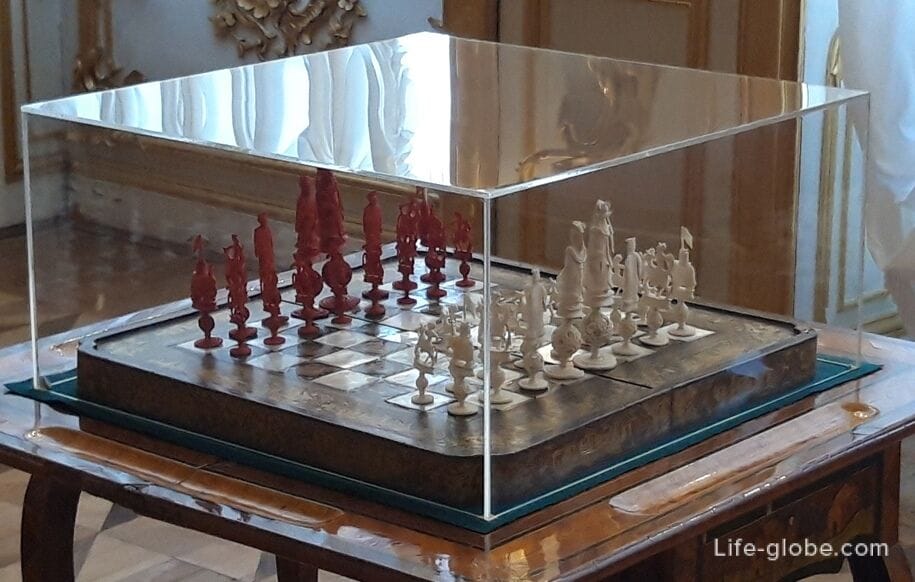
In the hall there is also a secretaire made by the German master furniture maker A. Roentgen - one of the rare examples of set furniture in the style of "feathery rocaille", characteristic of the products of the famous workshop of the 1765-1770-ies.
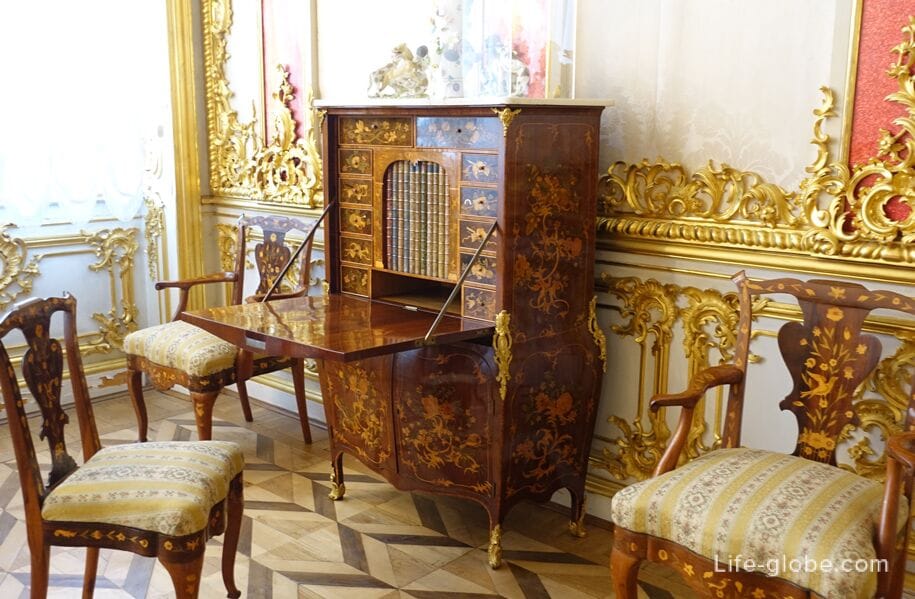
Green Pillar under Catherine II served as a pantry, which stored silverware and porcelain.
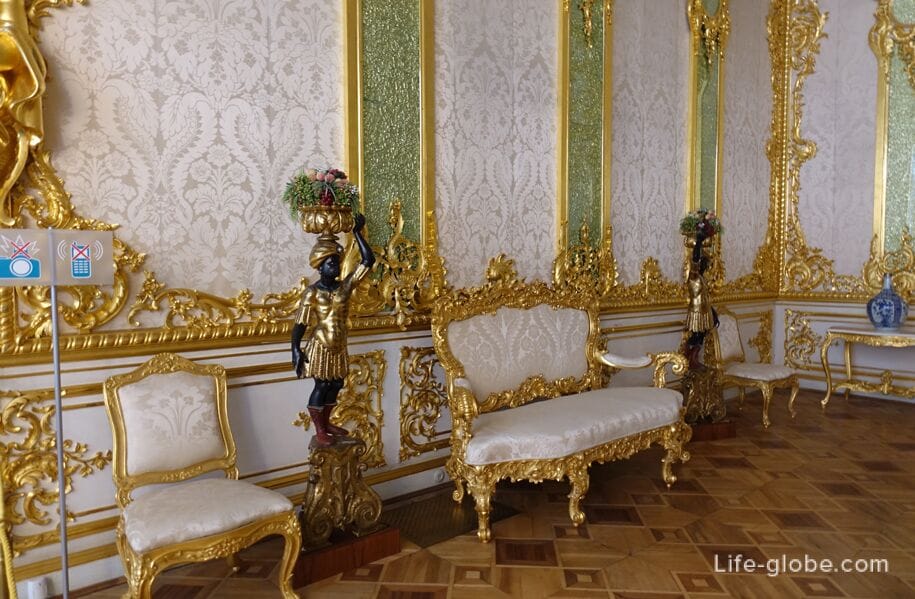
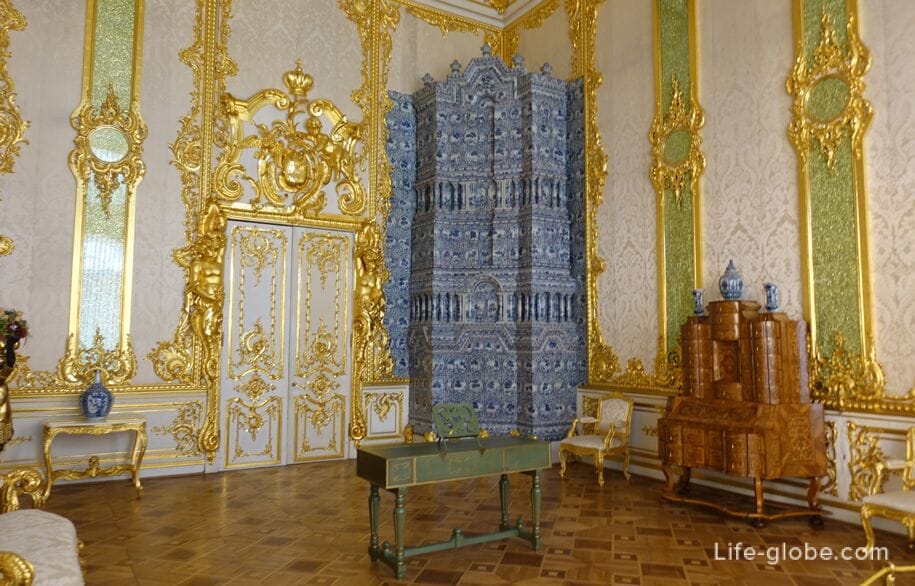
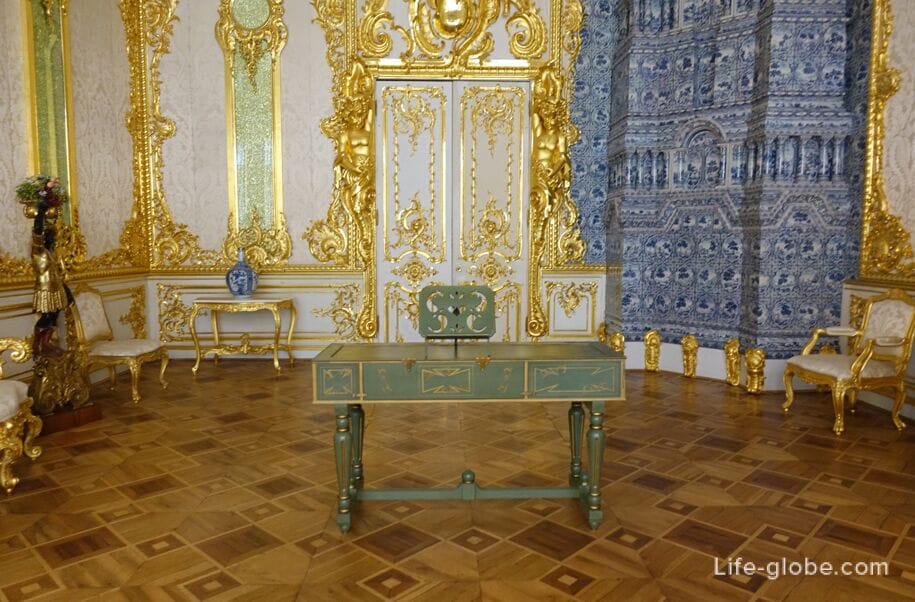

The ceiling of the Green Pillar is decorated with a plafond with a composition on the plot "The resting commander hears the call of the Muses", recreated by the artist V. A. Lednev from pre-war photographs.

Portrait Hall
In the Portrait Hall of the Catherine Palace, ceremonial images of royal persons have long been displayed.
Now on the walls, covered with a white patterned damask framed with gilded carvings, there are ceremonial portraits of Catherine I by I. Adolsky and Elizabeth Petrovna by G. Buchholz, as well as portraits of Grand Duchess Natalia Alekseevna (sister of Peter I) and Catherine II, executed by unknown painters of the 18th century.
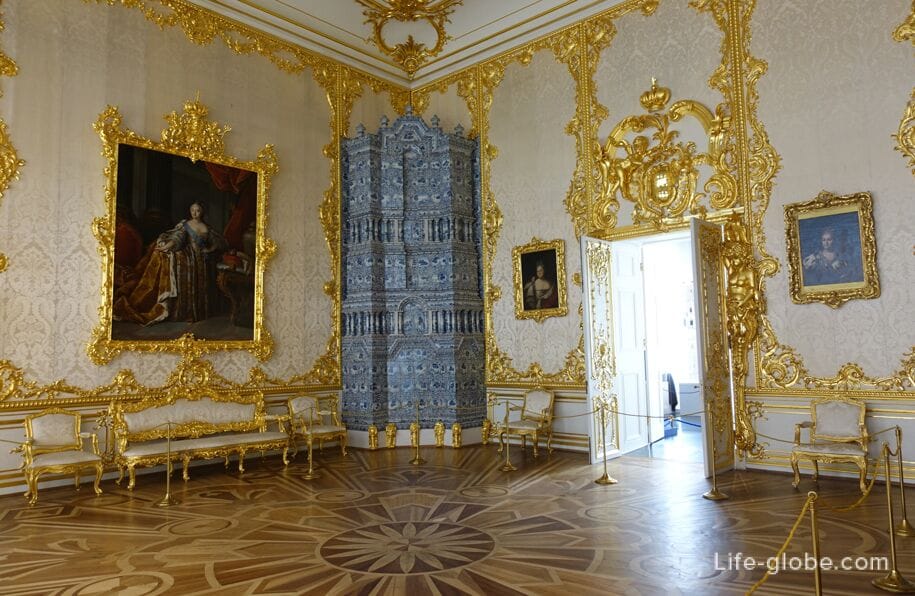
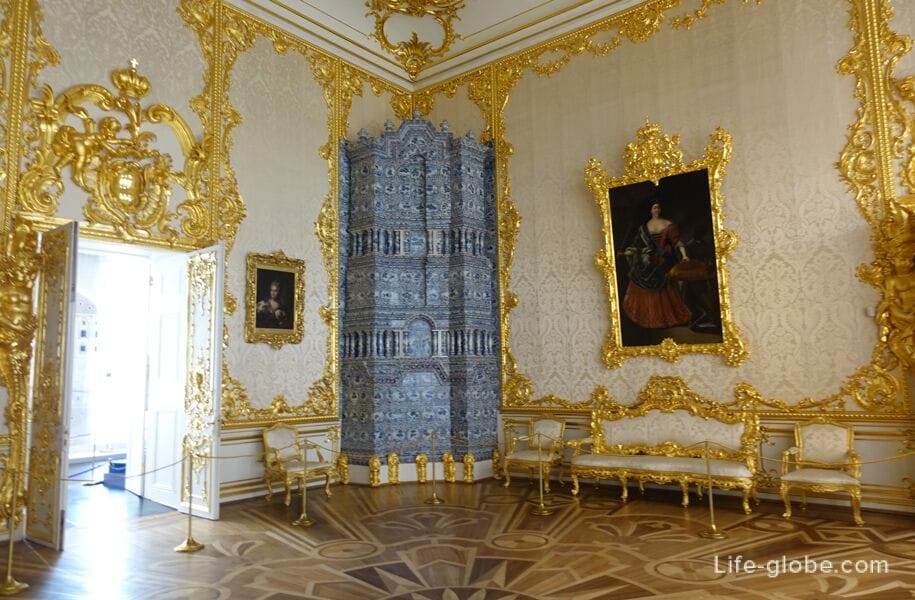
The ceiling of the Portrait Hall is decorated with a picturesque plafond "Mercury and Glory", transferred to Tsarskoe Selo from the Yusupov Palace in St. Petersburg, made, according to Italian experts, by a representative of the Venetian school D. Scaillario.
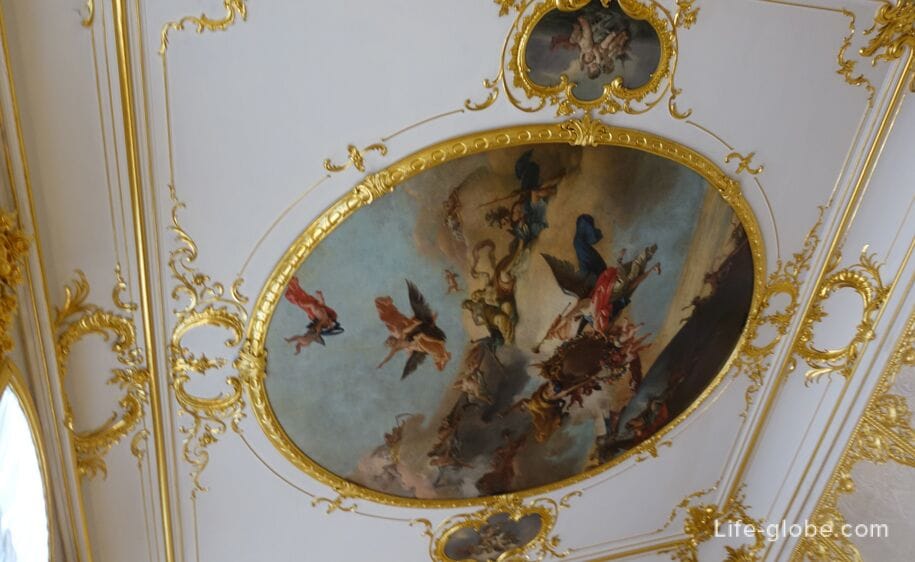
The Amber Room
The Amber Room is the pearl of the Catherine Palace, the origin of which is covered with legends and myths.
The amber room was originally created by the Electors of Brandenburg (King Frederick I of Prussia and his wife Sophia Charlotte), who owned Prussia, the European center of amber production. The idea to create the amber hall was started by the amber frames presented to the couple in Konigsberg (now the city of Kaliningrad). At first, the amber hall was planned to be created in the Litzenburg Palace (the author of the design project Eosander), and then-the Oranienburg Palace, which eventually contained only elements of the future amber room. The idea was never realized in any of the palaces.
During the lifetime of Frederick I, he examined the finished panels for the Amber Gallery during one of his visits to Berlin (in 1712 or 1713) Peter I, who did not hide his admiration and desire to have such a creation at home.
The heir to the first Prussian king, Frederick William I, imposed a strict discipline focused on practical benefits, and stopped all expensive work in his father's palaces. Subsequently, the amber panels were presented to Peter I and sent to St. Petersburg in 1717. During the reign of the Empress Elizabeth (daughter of Peter I), the panels were installed in the Catherine Palace and formed the famous Amber Room. During the Great Patriotic War, the "room" was taken out by German troops.
Konigsberg Castle is the last known location of the legendary amber Room (1942-1945). During the storming of Konigsberg by Soviet troops in April 1945, the Amber Room disappeared without a trace. Its further fate still remains one of the mysteries of history and there are several versions on this account.
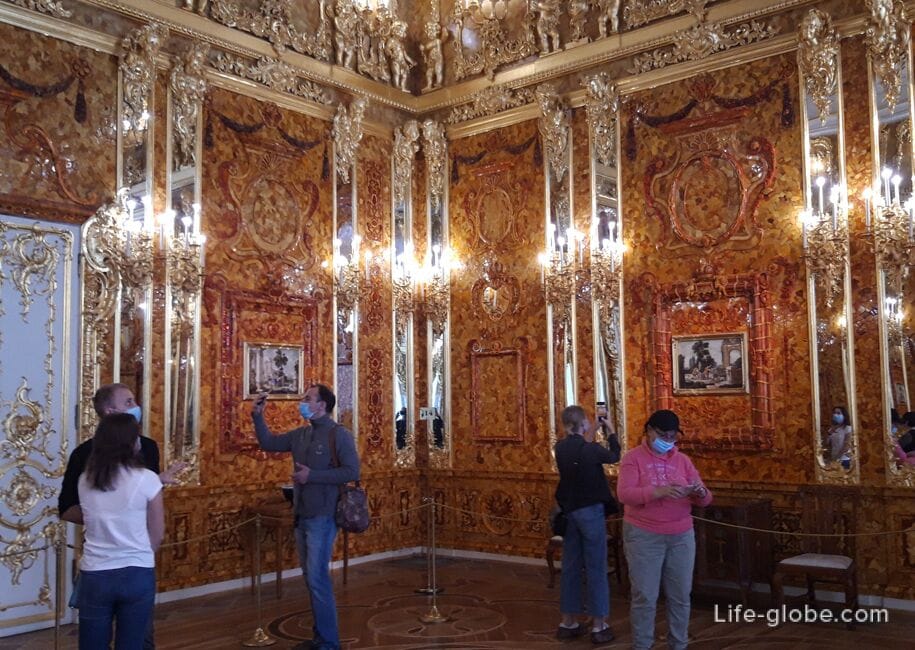
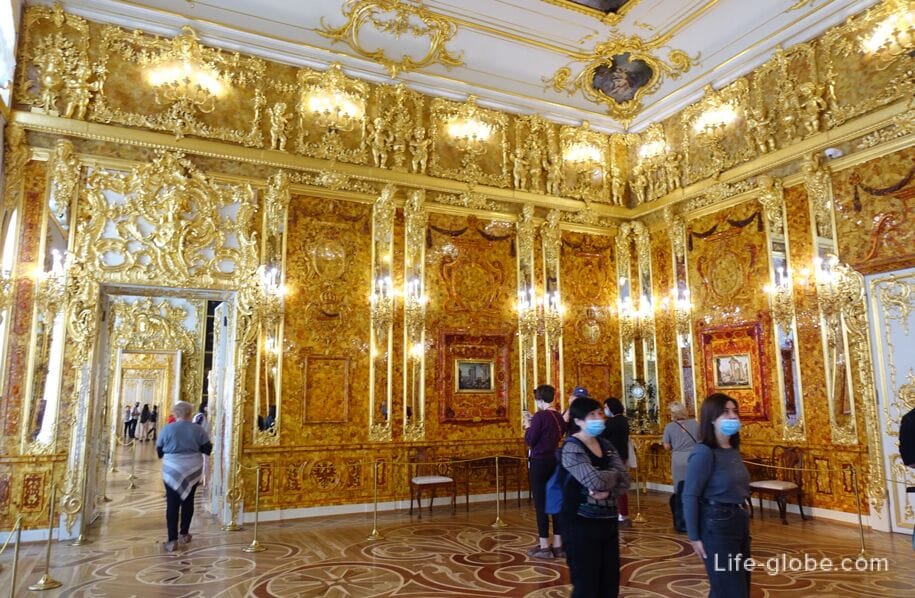
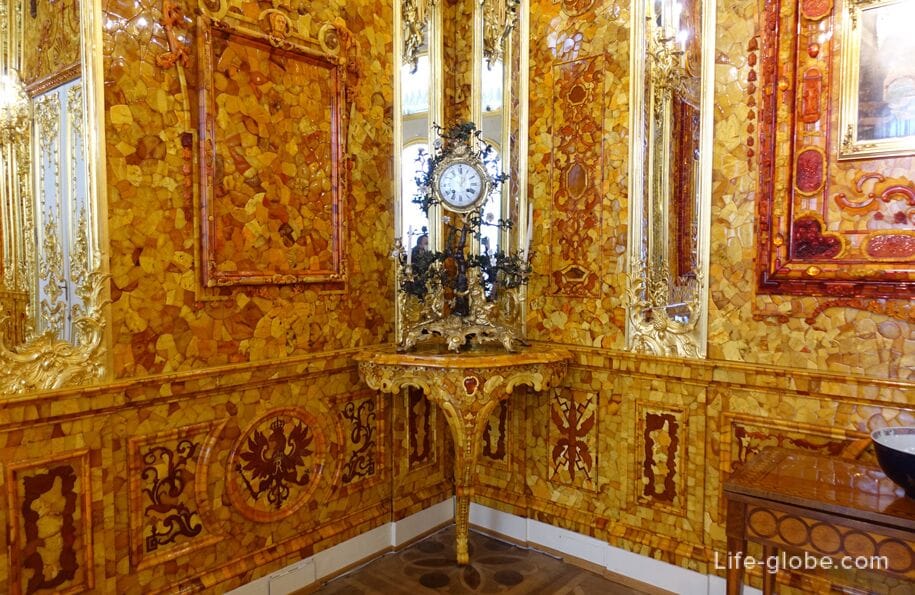
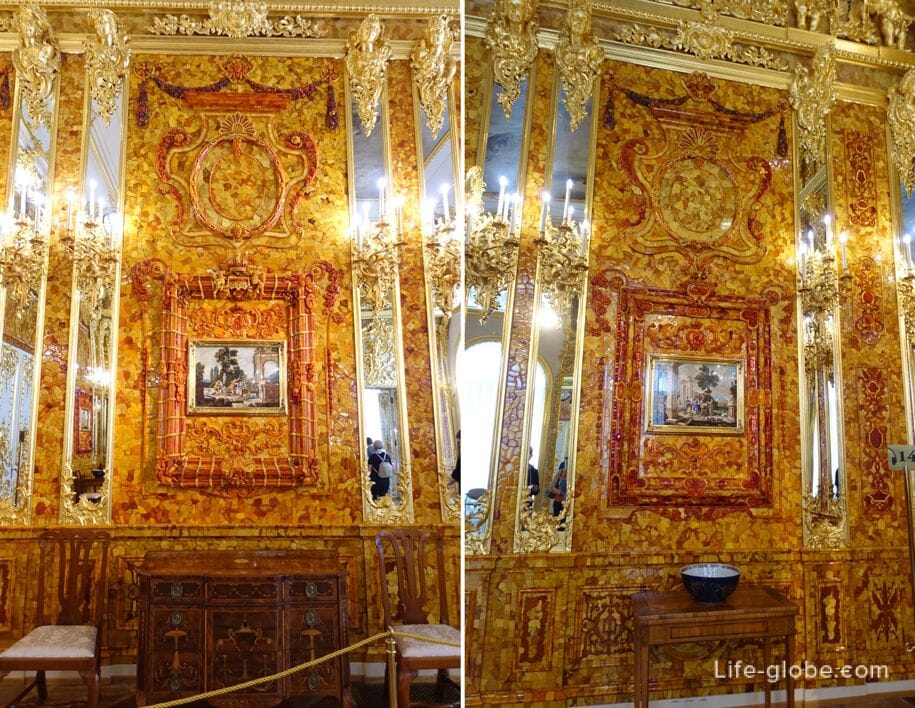
Ceiling light in the Amber Room
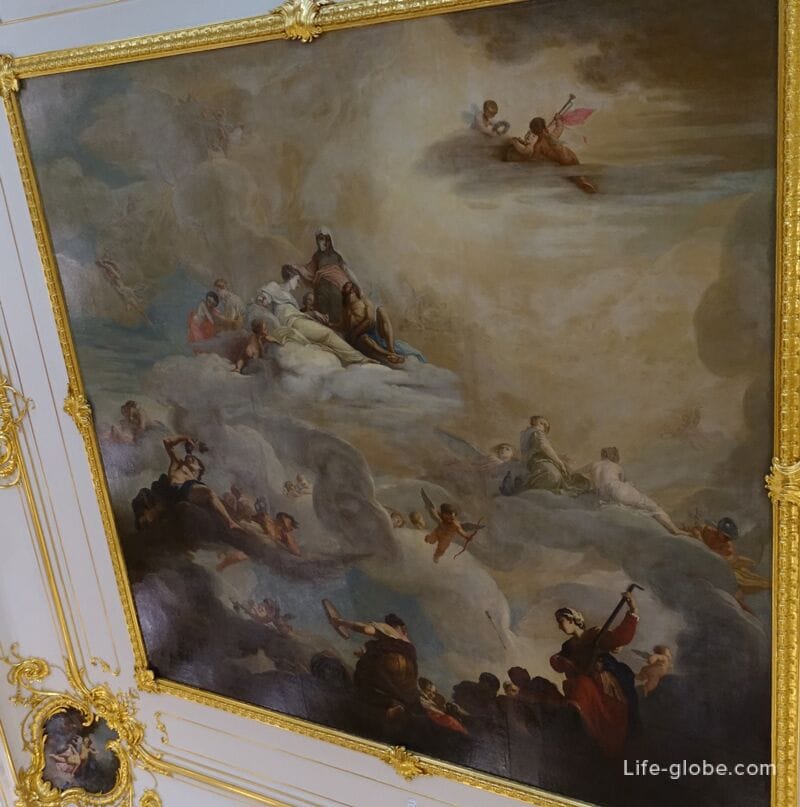
Art Hall
The hall got its name due to the paintings placed on the walls on the principle of trellis hanging.
The picture hall extends the entire width of the palace, and its area is about 180 square meters. In the 18th century, the hall was often used for diplomatic receptions, meals and musical evenings, and during the Seven Years 'War (1756-1763), it hosted meetings - "conferences at the highest court". In the summer of 1757, a reception was held in this hall in connection with the delivery of banners and keys from the conquered Prussian cities.
The main part of the Tsarskoye Selo collection of paintings, presented in the hall, was purchased by order of the Empress Elizabeth Petrovna in 1745-1746 in Prague and Hamburg by the artist G.-H. Groot. It includes works by Western European masters of the 17th and early 18th centuries.
A special place in the hall's collection is occupied by two paintings: P.-D. Martin Jr. "The Battle of Poltava" and "The Battle of Lesnaya", painted by order of Peter I, who wanted to preserve the memory of the glorious victories of the Russian army in the Northern War. The emperor himself did not see the paintings - they arrived in Russia after his death.
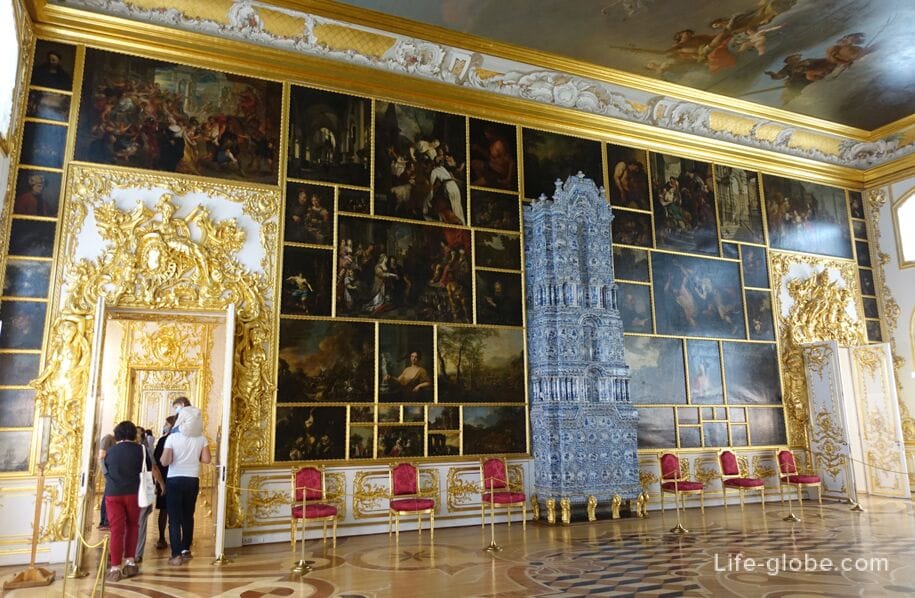
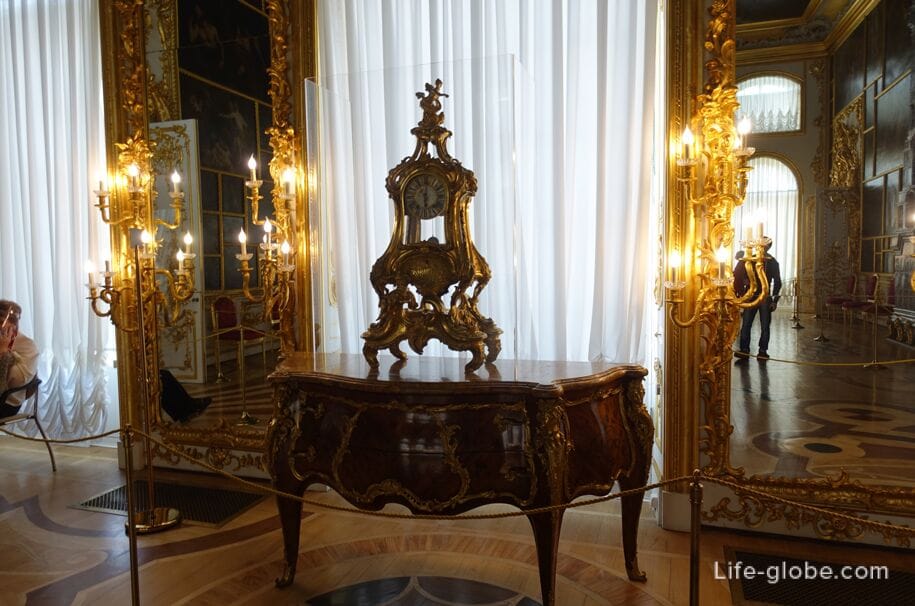
The ceiling of the hall is decorated with the "Olympus" plafond - a post-war copy of the plafond of the Jordan Staircase of the Winter Palace, executed by the artist G. Diziani.

Small White Dining Room
The Small White Dining Room was the beginning of the private apartments of the Empress Elizabeth Petrovna, and later-the Empress Catherine II, who in turn passed them to her beloved grandson-Grand Duke Alexander Pavlovich, the future Emperor Alexander I.
The hall is decorated with carvings on the walls and carved desudeports, a Baroque oven and a white damask on the walls.
The room contains authentic objects preserved during the evacuation: views of the Great Tsarskoye Selo Palace and the park by F.-H. Barisienne, three landscapes of J. Delabart, depicting Catherine Park, and a painting by F. Ya. Alekseev with a view of the Cameron Gallery.
The hall is also notable for the carved gilded chairs of Russian work of the mid-18th century and the bureau of typesetting wood made in the 1770s by the Okhta master N. Vasiliev.
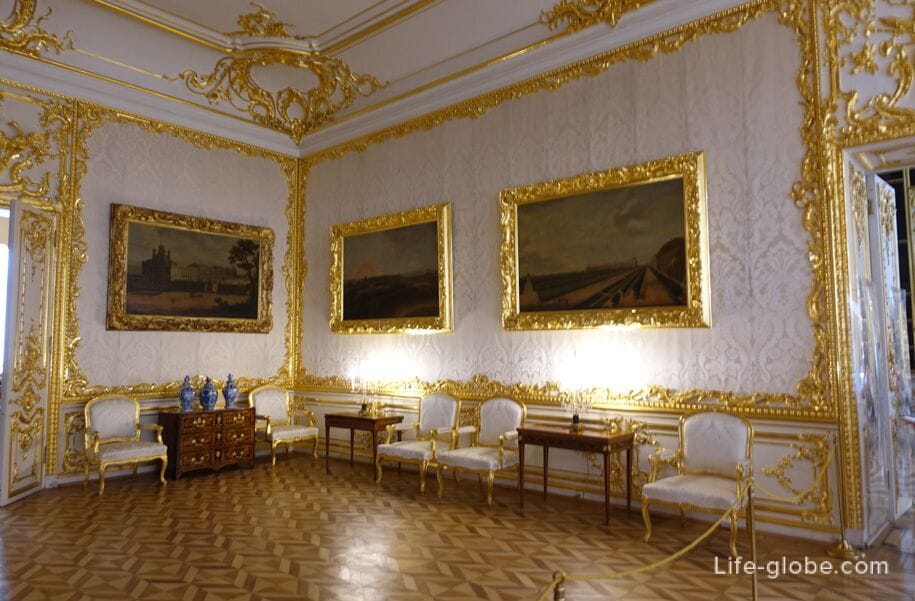
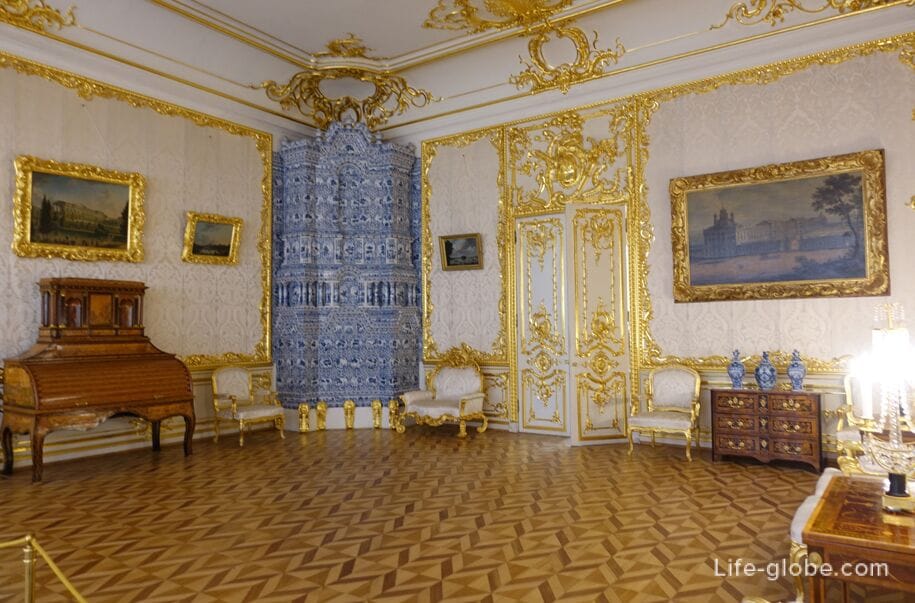

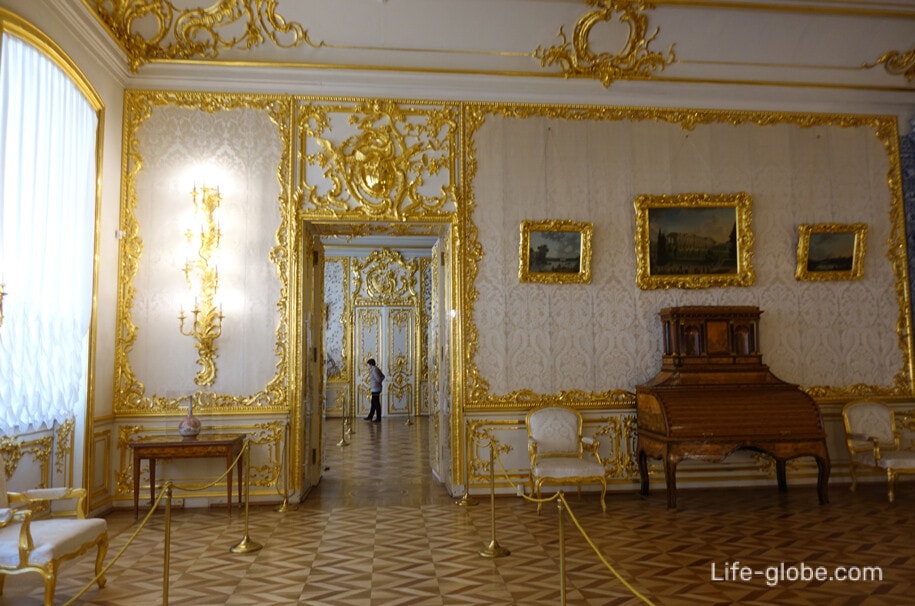
For the ceiling of the hall, a copy of the painting K was used. Vanloo "Bathing of Venus".
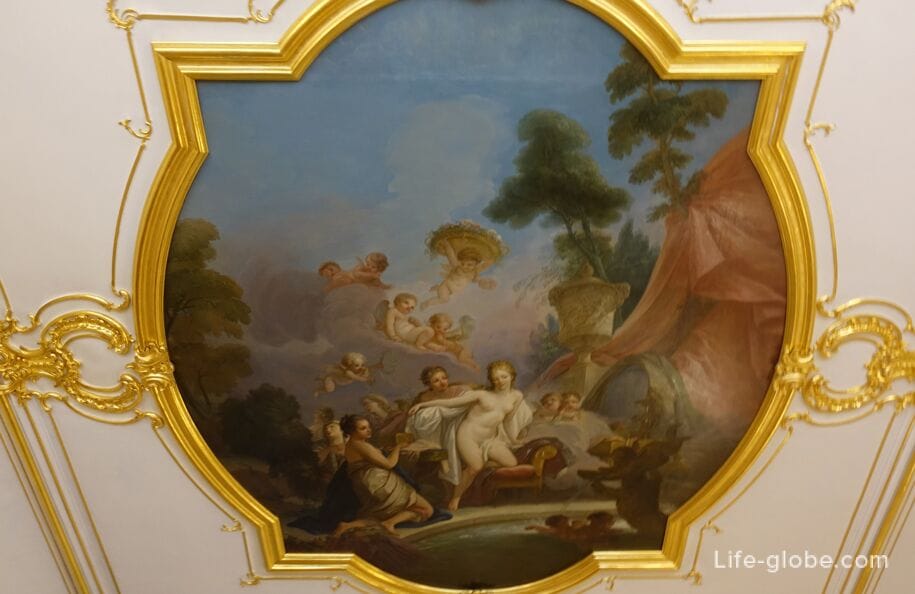
Alexander I's Chinese Drawing Room
The Chinese drawing room of Alexander I belonged to the personal imperial chambers.
The wall covering is made of silk with Chinese-style painting.
The paintings and furnishings of the living room, preserved in the evacuation, now occupy their historical places. The walls are decorated with portraits of Peter I and Catherine I, their daughters - Anna and Elizabeth, Empress Anna Ioannovna, a portrait of Emperor Peter II by I.-P. Luden, as well as a portrait of Catherine II (a copy from the work of I.-B. Lampi the Elder) and a portrait of Alexander I by D. Dow.
On the card tables and chests of drawers are items of Japanese and Chinese porcelain and products of the Berlin Royal Porcelain Manufactory, made in the 18th century. Unique is the chest of drawers from the palace collection, inlaid with ornamental metal decor.
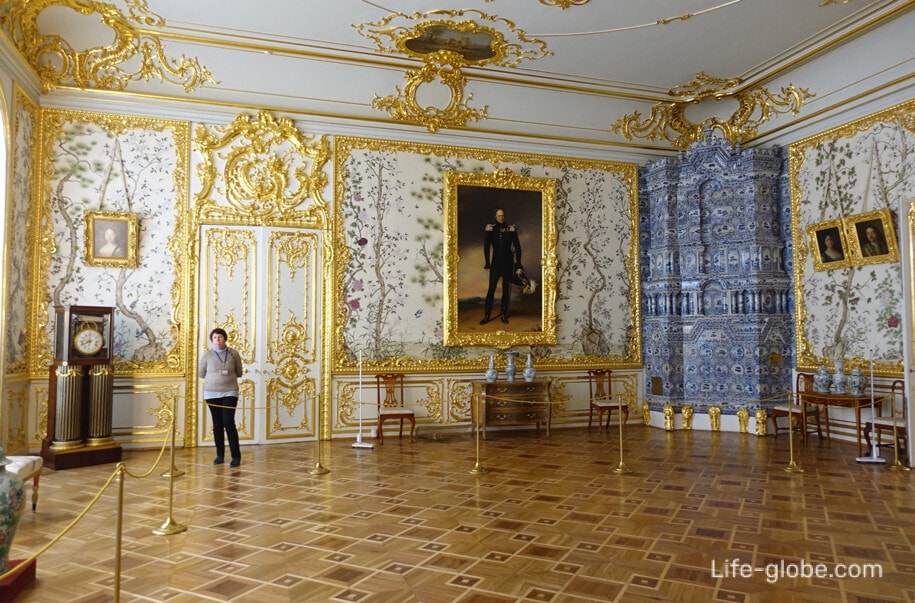
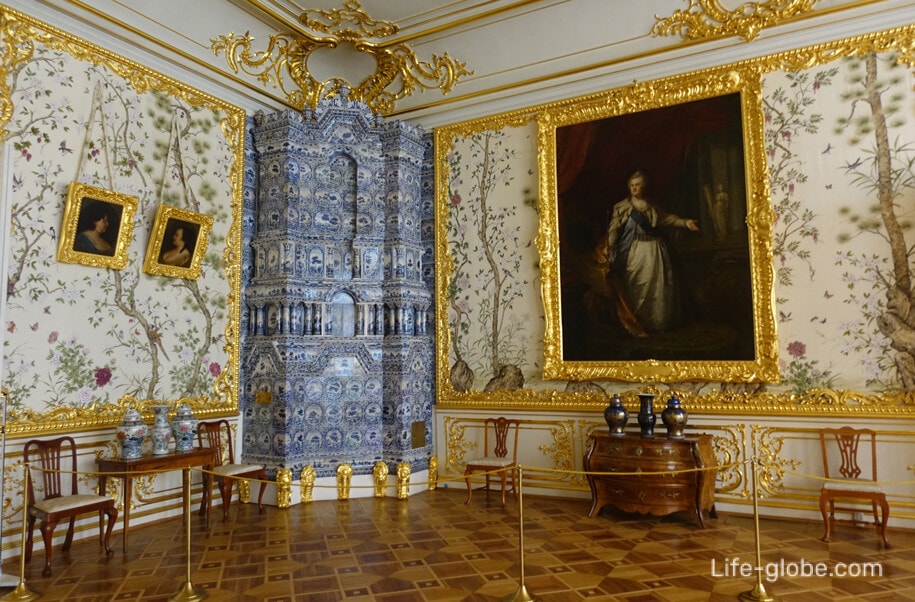
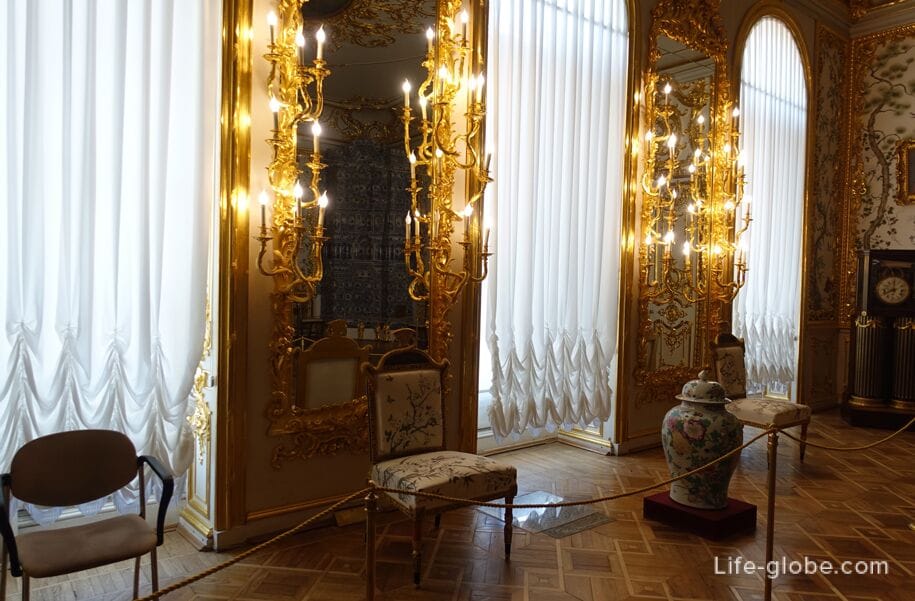
The ceiling is decorated with a copy of the painting by F. Boucher "Venus disarming Cupid", surrounded by four compositions of "The Game of Cupids" in a stucco gilded frame in the form of climbing shoots.
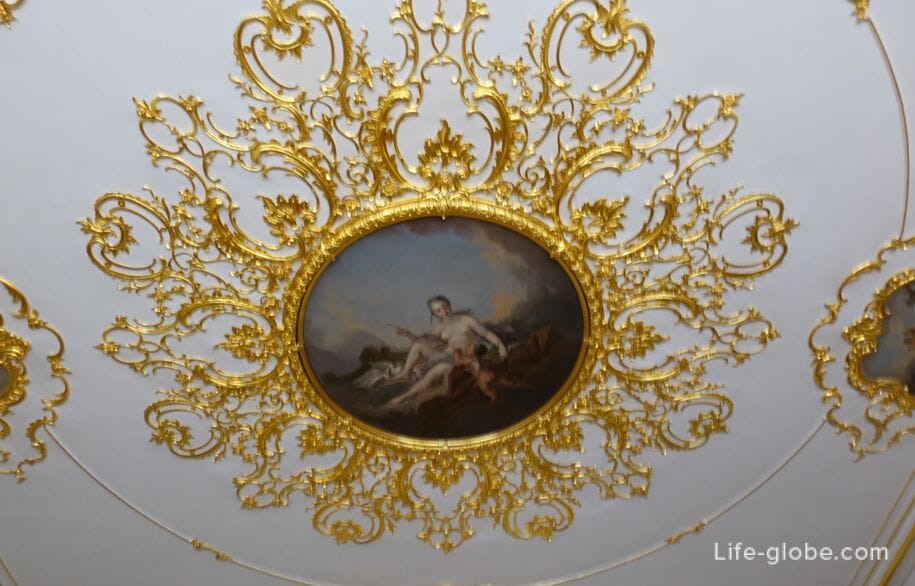
Pantry
The pantry belonged to the private chambers of the Empress, and until 1761 was part of the Lavatory on the half of Elizabeth Petrovna. In the middle of the 19th century, the room was divided by a white damask partition, behind which a service buffet was arranged for serving tables during receptions.
Today, a stove with painted tiles is installed in the corner of the room. In the wall between the windows facing the palace square, there is a mirror in a carved gilded frame with two sconces.
For the plafond, a painting by the famous Italian artist of the 17th century P. da Cortona (1596-1669)" Coral fishing " was used, which was transferred to Tsarskoye Selo from the funds of the State Hermitage Museum in the post-war period.
The furniture of the Pantry dates back to the 18th century: baroque armchairs made by domestic masters, a French chest of drawers made of wood from the 18th century and bean-shaped tables made in St. Petersburg workshops, one of which experts associate with the activities of the court furniture maker of Catherine II. Meyer.
Also in the hall are two Western European still lifes of the 17th century and two animal compositions by the artist I.-F. Groot, painted in the middle of the 18th century for the Tsarskoye Selo pavilion of Montbijou.
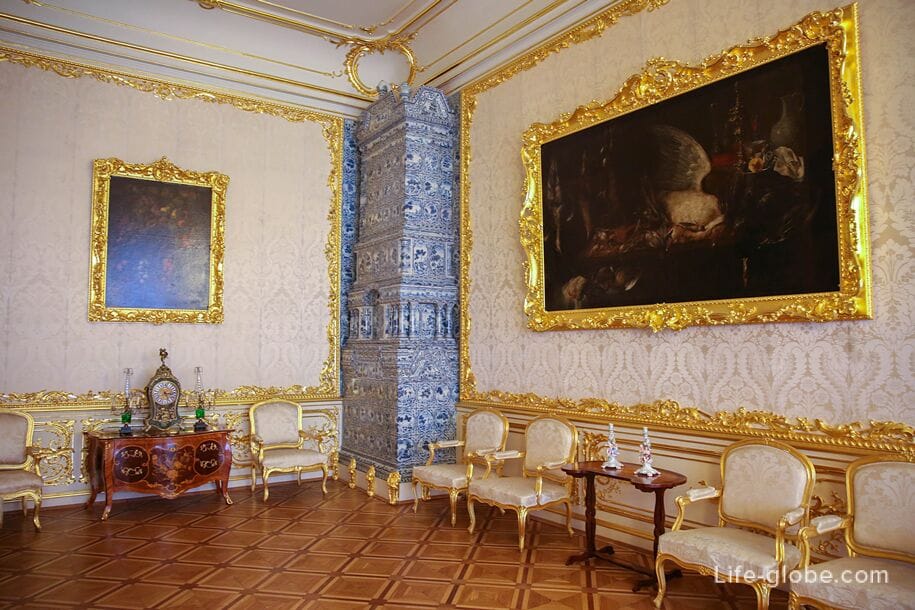
The room in front of the Cast iron staircase
In 1768, the room that served as the lavatory of the Empress Elizabeth Petrovna was divided into two rooms. In the 1770s, the area of the smaller of the rooms was again reduced due to the construction of an internal wooden staircase. In 1817, the wooden staircase was replaced with a cast-iron one, after which the "Room in front of the cast-iron staircase" got its name.
Now the wall of this small room is covered with a white damask in carved gilt frames. Opposite the window is a false window with mirrored glass, visually expanding the space.
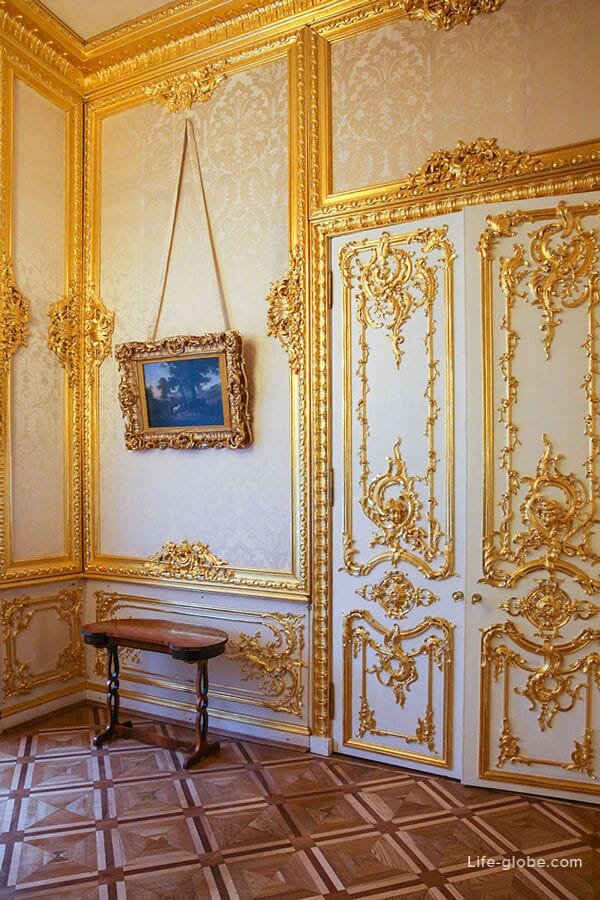
Oval front
This is a small passageway room that led from the private chambers of Grand Duchess Maria Feodorovna to the private half of Emperor Alexander I. The room served as a service room and, being the first room of the personal half of Alexander I, connected his chambers with the rooms of the Grand Suite, which at that time was occupied by his wife, Empress Elizabeth Alekseevna.
The room has no windows; its walls are almost completely occupied by four doorways, two of which have mirrored doors. The walls are lined with artificial marble of a warm pale yellow color, the ceiling is decorated with ornamental paintings in the grisaille technique, the floor is laid with a set parquet made of precious wood.

Vaulted passage
The vaulted passage, which was also called the Arch Room by its box ceiling, led to the State Office of Emperor Alexander I.
The walls of this small room are lined with white artificial marble.
In the Entrance Hall there are: a cabinet for engravings of French work, chairs and armchairs made by domestic masters, as well as candelabra (France, 1820s) and a vase with the image of the "Battle of Brienne" (France, Sevres, 1814).
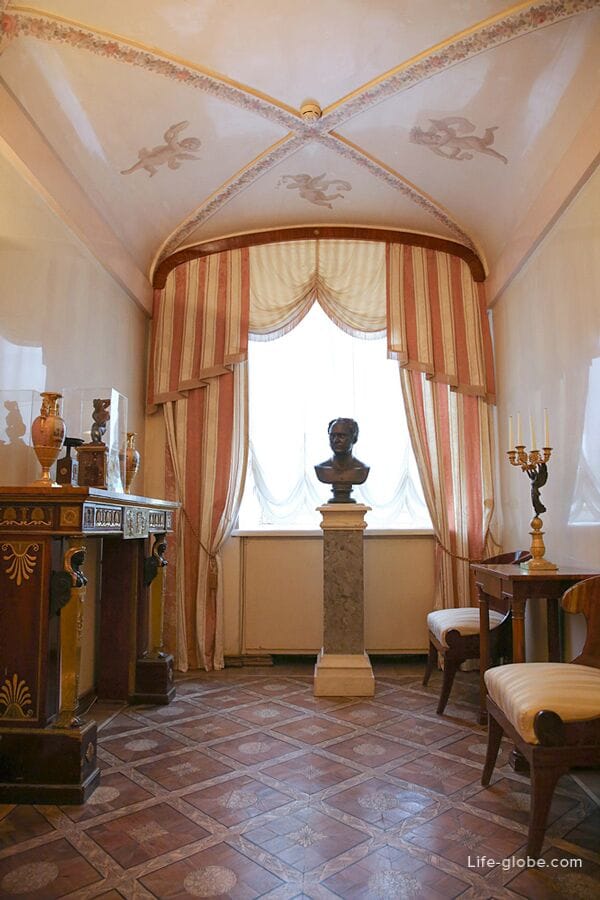
Small passageway
This small room with a single window facing the Catherine Park is part of the extant Karelian Reception Room of Alexander I, created by V. P. Stasov in 1817.
The current setting of the Small Entrance Room is made up of items of Russian and Western European decorative and applied art of the first quarter of the 19th century: a gilded and patinated bronze clock "Homer Worship" by Parisian masters V. Ledur and L. Ravriot, a bronze bust of Jupiter, as well as poplar chairs and armchairs made in the workshop of A. I. Tour in the 1820s.

State (marble) office of Alexander I
The cabinet was designed by V.P. Stasov in 1817 and was intended for important official audiences.
The office has a strict simple finish: the entrance is interpreted in the form of a deep semicircular niche, separated from the main interior space by two Ionic columns; the walls are lined with light pink artificial marble, with which the second name of the office is associated; the floor is parquet.
The study will be made at the Imperial porcelain factory vase with a painting depicting the entry of Alexander I into Paris in 1814; mantel clock with bronze figure of Julius Caesar created (not later 1817) master L.-F. Vecherom; on the desktop of the Emperor exhibited to him the products of the Ural malachite made in the first quarter of the 19th century at the Peterhof lapidary factory - a written instrument, table lamp, get some paperweights, chandeliers and decorative vases.
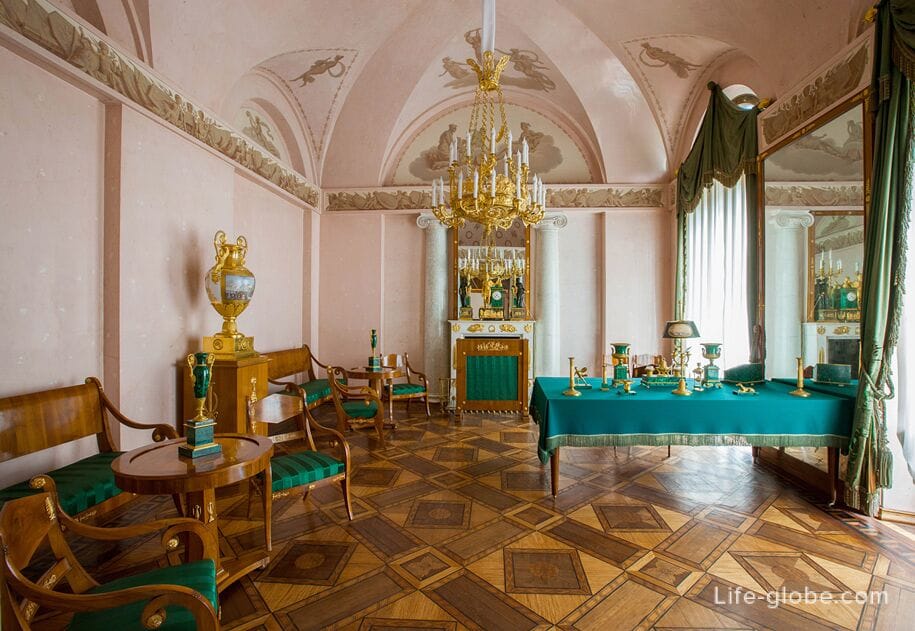
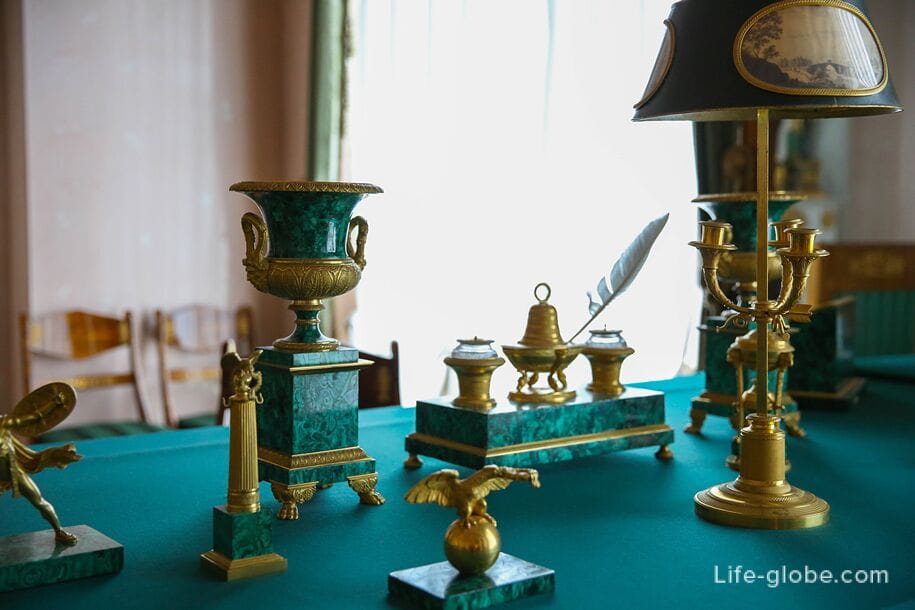
Waiter's room
The waiter's room is one of the service rooms of the Great Tsarskoye Selo Palace of the 18th century.
The room is decorated with wooden pilasters painted in marble and connected by plaster arches.
the Waiter's Room features late 18th-century card tables, a Swedish chest of drawers from the second half of the 18th century, and mahogany chairs made by Russian carpenters in the 19th century.
On the walls are paintings from the Tsarskoye Selo collection: "Mountain Landscape" by B.-E. Murillo, "View from the Palatine Hill" by P. Labruzzi, "Waterfall in Tivoli" by A. Locatelli and "Ruins" by A.I. Belsky.
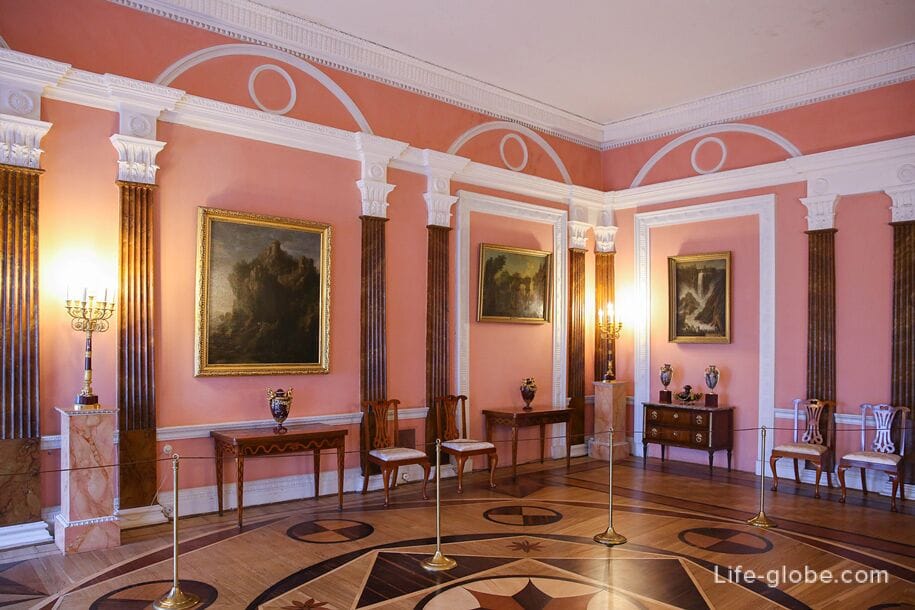
Green dining room
From the Green Dining Room began the private rooms in the northern part of the palace, created in the 1770s by decree of Catherine II for Grand Duke Pavel Petrovich (the future Emperor Paul I) and his first wife Natalia Alekseevna. These rooms were built on the site of the hanging garden, a huge terrace built by f. Rastrelli.
The soft green walls of the dining room are covered with white stucco ornaments based on the motifs of ancient villa paintings. The sculptural decoration of the hall is complemented by medallions with dancing cupids and multi-figure compositions on mythological subjects, the relief of which is emphasized by a pink background.
The doors of the room are decorated with grotesque ornaments dating back to ancient Roman paintings.
The parquet floor is made of oak, light maple and mahogany.
In the room there are chairs, a fireplace with fireplace appliances, a candelabra and a table with items of table service decorated with the monograms of the former owners.
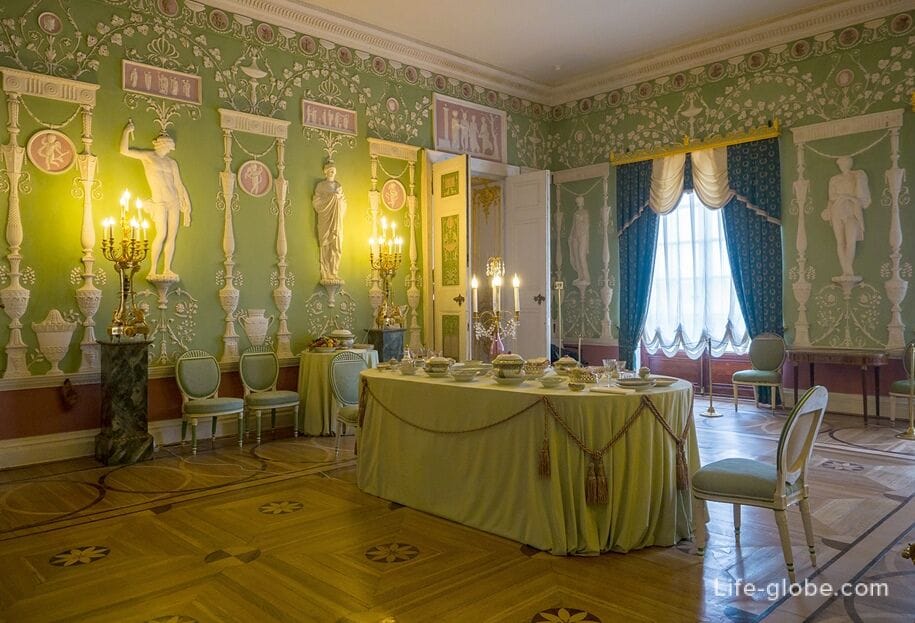
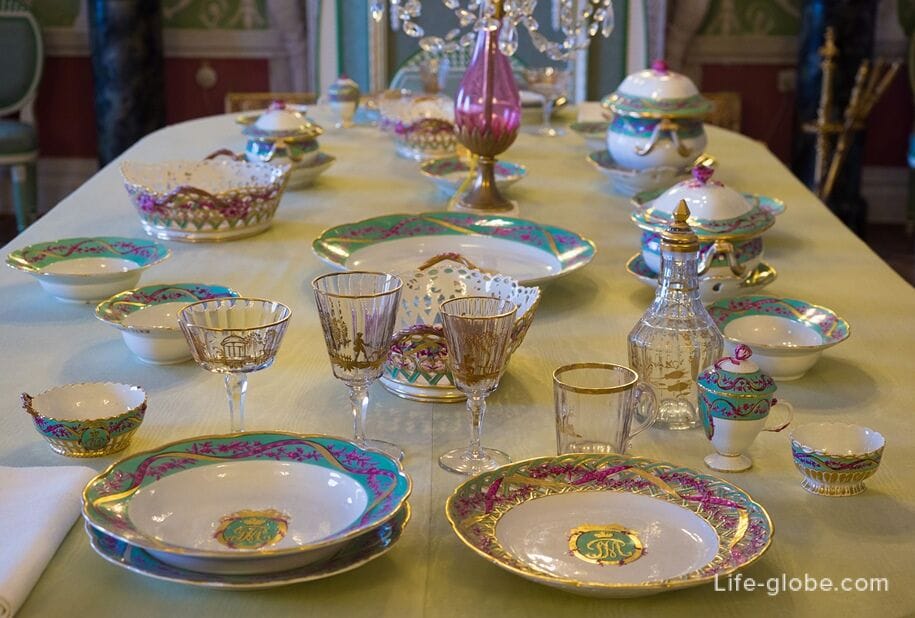
Front Blue Living Room
The grand Blue drawing room is the largest and most elegant room in the apartment, created by C. Cameron in 1779-1783.
Ceremonial purpose of the room highlights the rich and varied decoration: walls covered with silk with blue flowers on a white background and complete gilded frieze of alternating oval vases and scenic medallions; paired fireplaces Carrara marble decorated with bas-reliefs and caryatids; on the West wall between the Windows, a large mirror in carved and gilded frames, completed medallions; gilt console, and door panels are painted with motifs taken from ancient grotesques; on the floor parquet floor from valuable breeds of wood with a predominance of rosewood and rosewood.
The hall is decorated with armchairs made in 1783 according to drawings by Charles Cameron in the workshops of J.B. Charlemagne-Bode. Some of them were saved during the evacuation, others were returned in 1947 from Konigsberg. The old fireplace grilles, pre-fireplace decorations in the form of reclining sphinxes and fireplace appliances made of gilded bronze, made according to drawings by Charles Cameron at the same time with the decoration of the hall, have been preserved.
Floor lamps with 17 candles made of blue glass with crystal and biscuit figures created at the St. Petersburg Glass Factory in the late 18th century, as well as candelabra of the early 19th century and vases depicting architectural landscapes (Berlin Porcelain Manufactory, early 19th century) and scenes from the history of Psyche (France, the first third of the 19th century) attract attention.
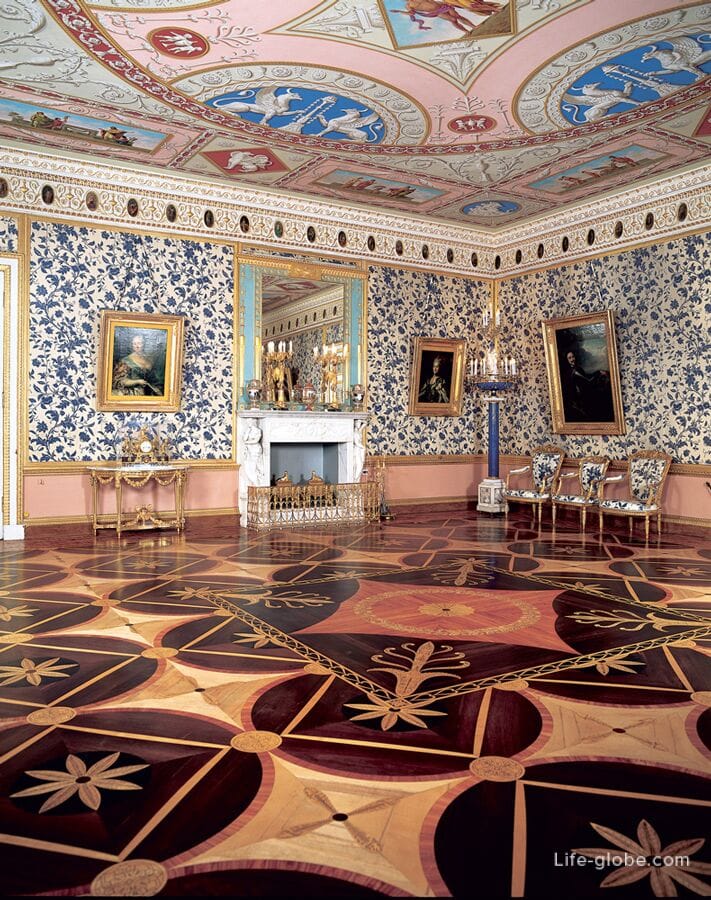

Chinese Blue Living Room
The name "Chinese Blue Living Room" is due to the fact that the walls of the room for a century and a half were covered with blue Chinese silk, decorated with landscapes and genre scenes.
The interior of the room successfully combines the motifs of Chinese decorative art with elements of classical interior design.
In the interior of the room, vases of Chinese porcelain from the 18th century, preserved in the evacuation, fireplace appliances and a grate made according to the drawing of Ch. Cameron and the models of J.-B. Charlemagne-Bode.

Pre-cathedral and Palace Church
Prechorny - two rooms that got their names due to the proximity to the choirs of the Palace Church.
One of the rooms had two windows facing the courtyard, and two more facing the Palace Church. The walls of the room are covered with golden silk with a woven pattern, on the floor there is a set parquet.
Here are the sofa and chairs created in the 1750s according to the drawing of F. Rastrelli.
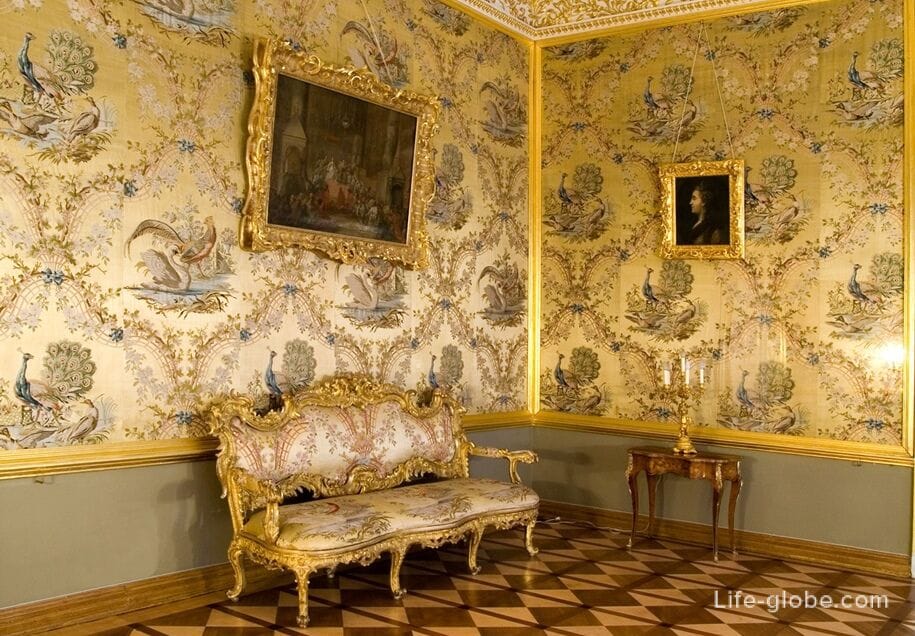
In the second-a Small pre-choir room, there is a bookcase, executed in the early 20th century by the French master A. Krieger, and also exhibits a "Still life with tulips" by an unknown European artist of the 18th century.
The Church of the Catherine Palace (Resurrection of Christ), which was the house church of the Romanovs, was laid on August 8, 1745 in the presence of the Empress Elizabeth Petrovna.
The interior of the church is dazzlingly elegant and today it is a separate museum of the palace ensemble (entrance is paid, from Sadovaya Street). Learn more about the Palace Church…
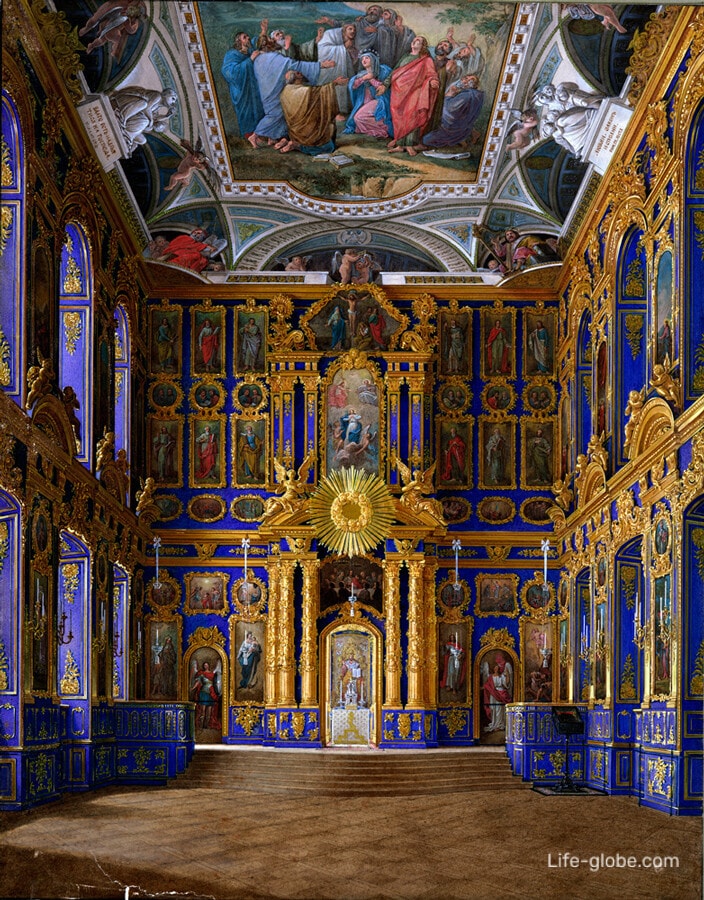
Passage room and Chamber-jungfer
In the Chamber-Jungfer leads another passage room, which houses the porcelain products of the famous English manufactory D. Wedgwood and English colored engravings of the second half of the 18th century.
Kamer-jungferskaya-a room with one window, which was originally intended for the palace maids.
The room is distinguished by a gilded stucco frieze and door sashes with colorful ornamental paintings. The white faience stove, designed by architect V. P. Stasov in the 1820s, is decorated with a bas-relief and a vase in the classical style. The furniture of the room is complemented by chairs made according to the drawing of Ch. Cameron, an elegant ladies ' bureau of the late 18th century with inserts in the "eglomise" technique, as well as paintings by artists of the Flemish, French, Italian and Dutch schools of the 17th and 18th centuries.
Bedchamber
Decorated in the early 1770s by V. I. Neelov, the room with two windows, two doorways and an alcove served as the bedchamber of Grand Duchess Natalia Alekseevna. Later it was rebuilt for Pavel Petrovich's second wife, Grand Duchess Maria Feodorovna.
The walls of the room are decorated with relief compositions based on Pompeian paintings. Along the walls and at the back of the room are slender columns of white faience, wrapped in gilded garlands. Plaster medallions with allegorical scenes symbolizing health, fun, well-being and prosperity were made by I. P. Martos. The small doors of the room are framed by a gilded baguette and decorated with rectangular panels with Arabesque paintings enclosed in the same baguette.
In the furniture of the Bedchamber, a steel table and a fireplace grate made by Tula blacksmiths for Catherine II stand out, as well as an elegant dressing table made of wood, created by Okhta carpenters Naskov in the 1770s for Grand Duchess Maria Feodorovna.
Also on display in the hall is a part of the furniture set, made by order of Catherine II by the French master Zh. Jacob, and a glass table from the Blue study of the Empress (Snuffbox).
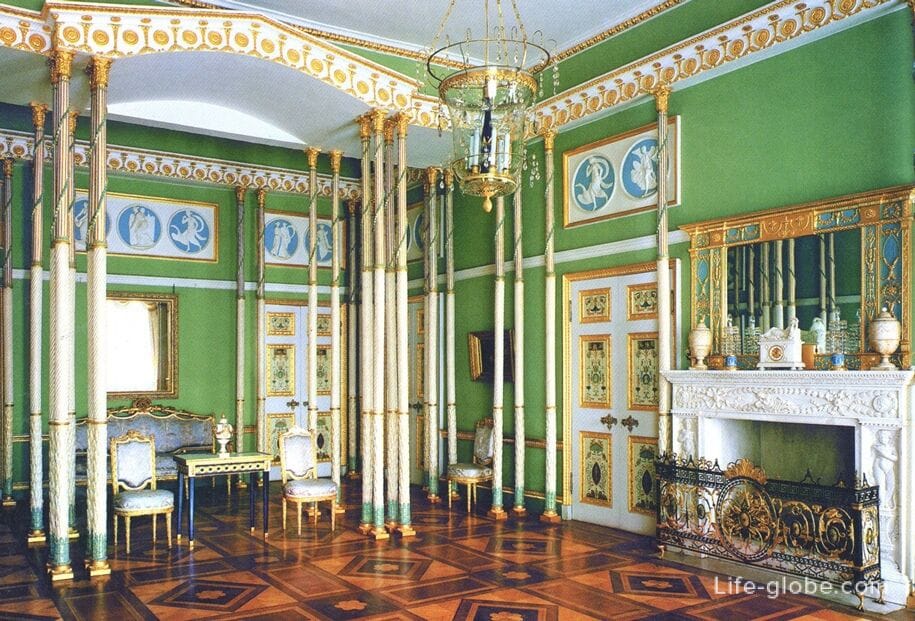
Painting and Sculpture rooms
These two small rooms were the offices of Grand Duchess Maria Feodorovna. The first was intended for painting and was called "Picturesque", and in the second the princess was engaged in modeling and bone carving, and it was called "Sculptural".
In the design The sculptural cabinet is dominated by relief decor. On the desk-jardiniere, decorated with watercolor views of Tsarskoye Selo, made at the end of the 18th century, there is a candelabra made of gilded bronze, made in 1783 by the St. Petersburg bronze workers Zh. Basselle and K. Sperling from a drawing by Ch. Cameron. The chairs by A. I. Tur and the gilded bronze chandelier with faceted crystal were created in the early 19th century. Of particular interest is the copy of the first half of the 17th century from the painting "Madonna and Child"by Parmigianino (Francesco Mazzola) displayed in the study.
On the walls of the Painting Room are the compositions "Spring" and "Autumn" by P.-Sh. Tremollers, as well as medallions depicting bouquets of flowers that once decorated the Dressing Room of Catherine II, the work of an unknown painter of the second half of the 18th century. Chairs made of wavy maple were made in the 1820s according to a drawing by V. P. Stasov in the studio of A. I. Tour and painted by the artist I. Bernasconi. On the table is a miracle lamp made of bronze and mother-of-pearl, made in the St. Petersburg workshop of V. Degen in 1825 and in August of the same year presented by the Dowager Empress Maria Feodorovna to her son - Emperor Alexander I.
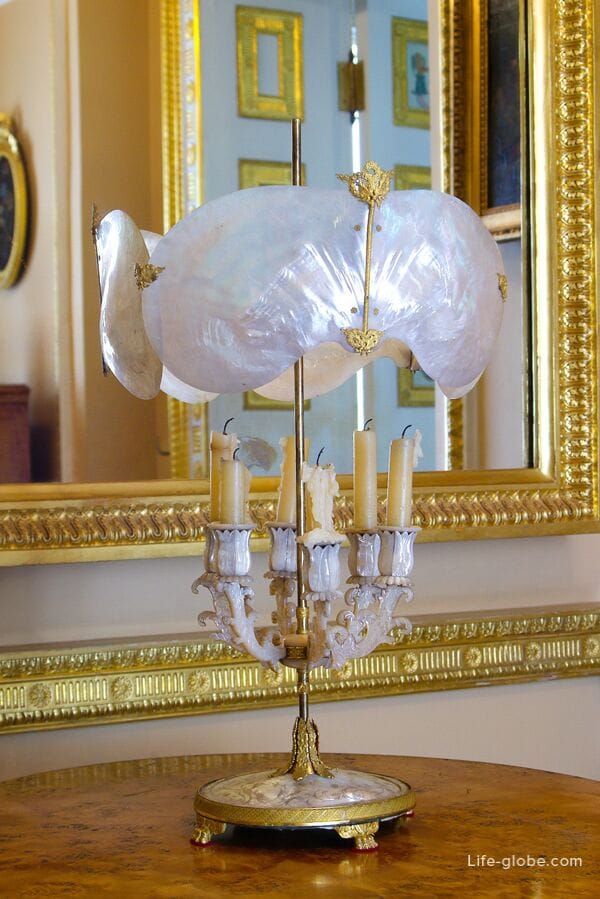
Stasovskaya Staircase (Church)
The Church (Stasovskaya) staircase was built in 1843-1846 by the architect V. P. Stasov (hence its modern name "Stasovskaya") and received the name of the Church due to the proximity to the hall leading to the Palace Church.
Before the Great Patriotic War, the inspection of the Catherine Palace began from the first covered entrance of the main facade of the building, located just behind the church wing, and entering the church entrance, visitors found themselves in front of the Church Stairs.
Before the war, the walls of the staircase were decorated with four large canvases by the French artist of the 18th century, G. Robert, and two compositions by P. Lemaire, obtained from the collection of the Imperial Hermitage.
During the Great Patriotic War, the Church Staircase was destroyed, and the paintings were stolen. In 1947, the works of P. Lemer were found among the many works of art exported from the USSR to Germany in Koenigsberg and, along with other Tsarskoye Selo masterpieces, were returned to the museum. Three of the missing paintings by G. Robber were obtained from the Hermitage and, finally, the fourth painting was recreated by restorers using pre-war iconography.
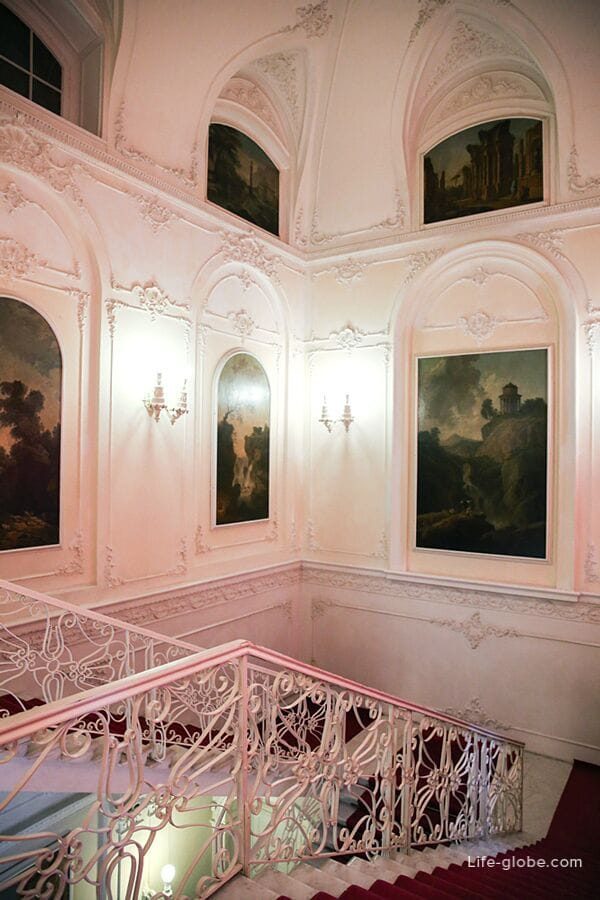
Small enfilade
In the Small enfilade of the Catherine Palace - six small rooms, the decoration of which was carried out without taking into account the historical mark, there is a permanent exhibition "Romanovs in Tsarskoye Selo".
In this part of the palace lived Elizabeth Petrovna and Catherine II and Grand Duke Pavel Petrovich (as a child). Alexander I also stayed here, and Nicholas II chose the rooms of the Small Suite to accommodate famous guests.
The exhibition has 7 sections, each of which is dedicated to one of the owners of the Tsarskoye Selo imperial residence-from Elizabeth Petrovna to Nicholas II.
The exhibits reflect the personal tastes, preferences and interests of the representatives of the Romanov dynasty.
In the halls are placed: ceremonial portraits, uniform dresses, furniture, writing materials, bronze and porcelain products, etc.

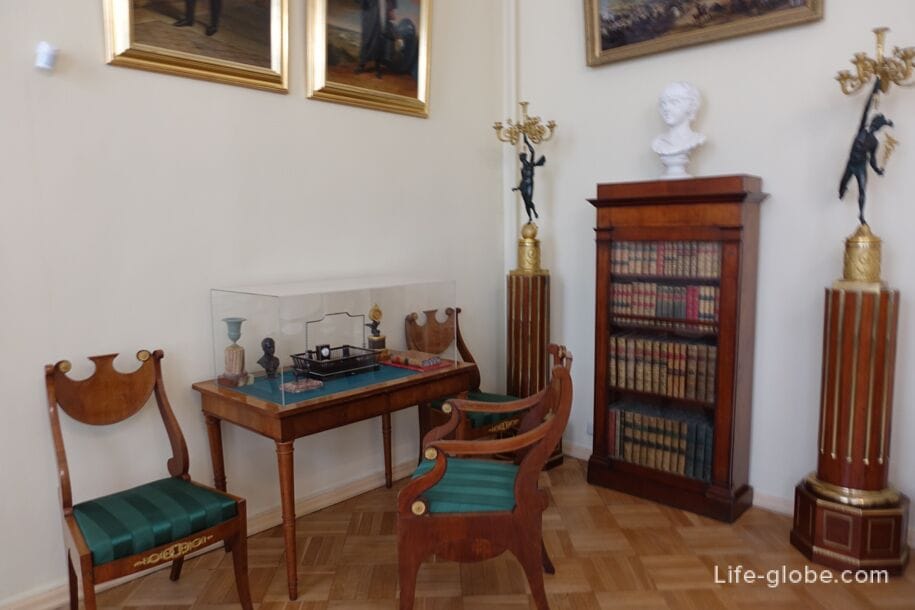
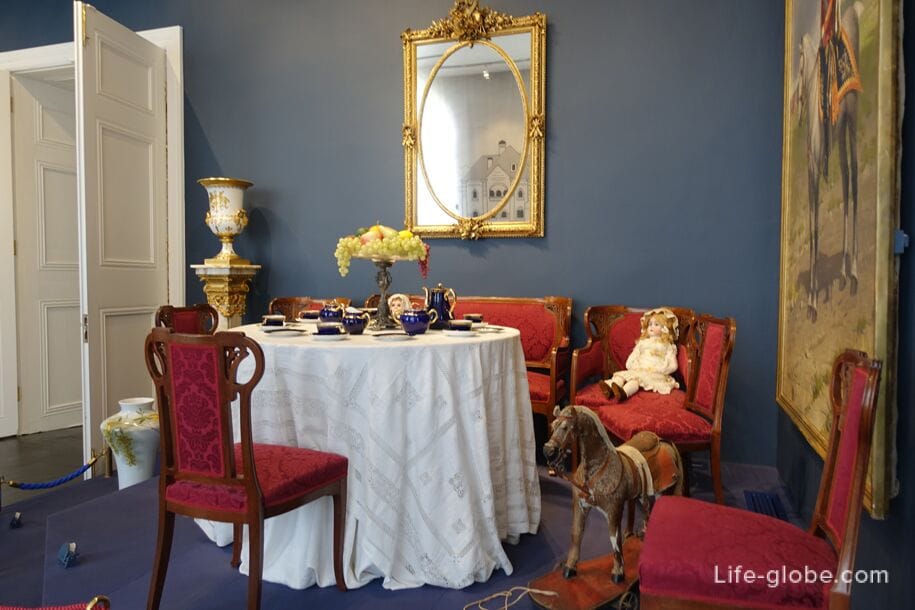
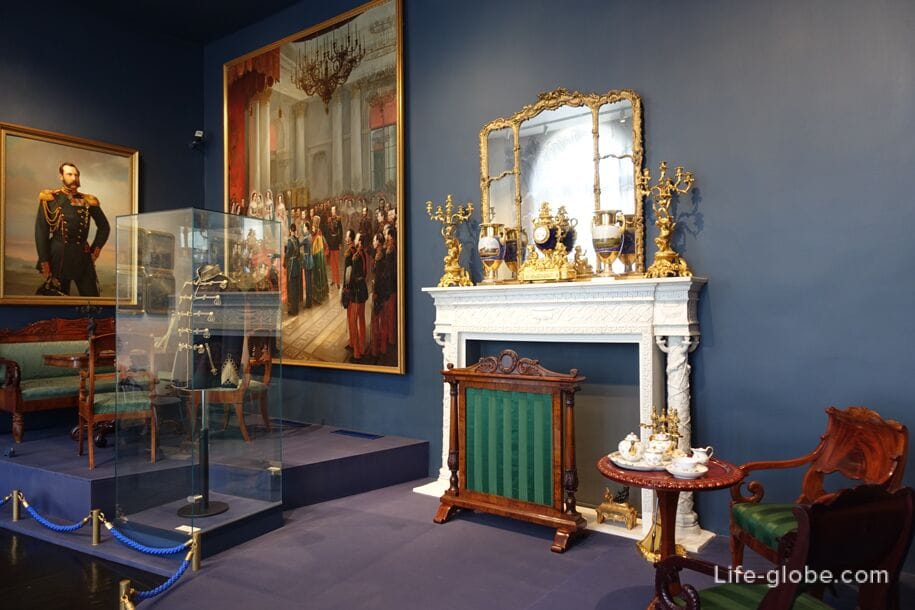

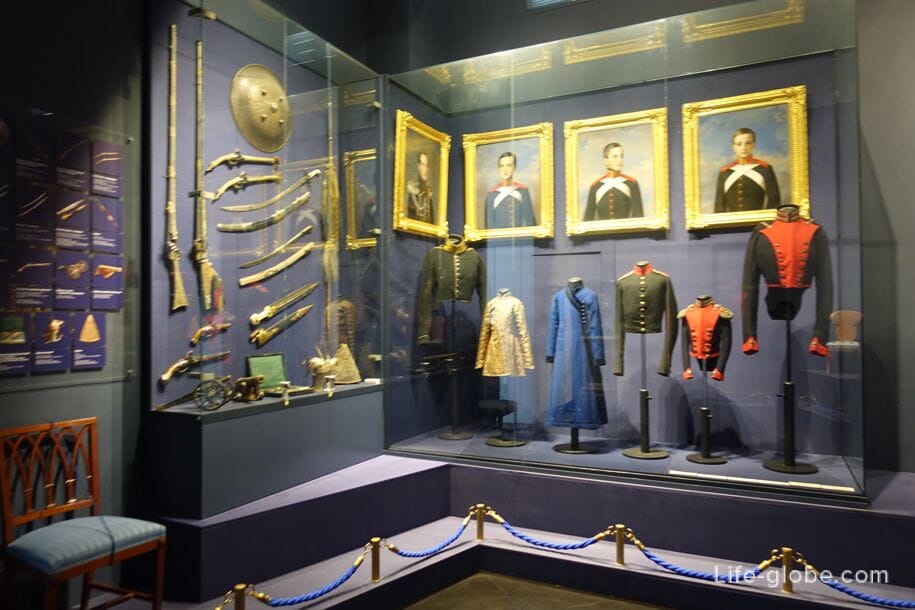

Practical information
The Great Catherine Palace, together with the adjacent Catherine Park, belong to The State Museum-Reserve "Tsarskoye Selo" and are located in Pushkin (St. Petersburg).
There are two routes through the halls of the Catherine Palace, each of which can be visited for a fee. The cost of tickets to the halls of the palace includes the cost of a ticket to the Catherine Park of the palace.
Routes to the Catherine Palace:
- I route of the Catherine Palace: Grand Staircase, Great Hall, I Anti-Chamber, Cavalier dining room, White Ceremonial Dining room, Crimson Pillar, Green Pillar, Portrait Hall, Amber Room, Picture Hall, Small White dining room, Chinese living room of Alexander I, Buffet, Green dining room, Waiter, Stass Stairs;
- II route of the Catherine Palace: Toilet, Lyon hall, the Arabesque hall, the Antechamber of III, II Antechamber, I Antechamber, a Large hall, exhibition room, the Grand staircase, the exhibition "the Romanovs in Tsarskoye Selo", the Amber room, an Art room, exhibition "Commemorative room of Alexander I", the state study of Alexander I, Arched entrance, front Oval, Green dining room, Ofitsiantka, Stachowska stairs.
All or part of the halls of the palace may be open to the public. Some of the exhibits in the halls and the routes themselves may also change.
Tickets can be purchased in advance online or at the ticket offices near the entrances to the Catherine Park.
The opening hours of the Catherine Palace and the park, the cost of tickets, as well as the conditions for visiting and buying tickets, we recommend that you check directly on the official website.
Website of the State Museum-Reserve "Tsarskoe Selo": tzar.
You can visit Tsarskoye Selo with one of the excursions
In Pushkin, near the Catherine Park and the palace, you can stay
The 5-star Pevcheskaya Tower Hotel features restaurants, a bar, a rooftop observation deck, free Wi-Fi and parking.
Breakfast is included in the room rate. Link to the hotel

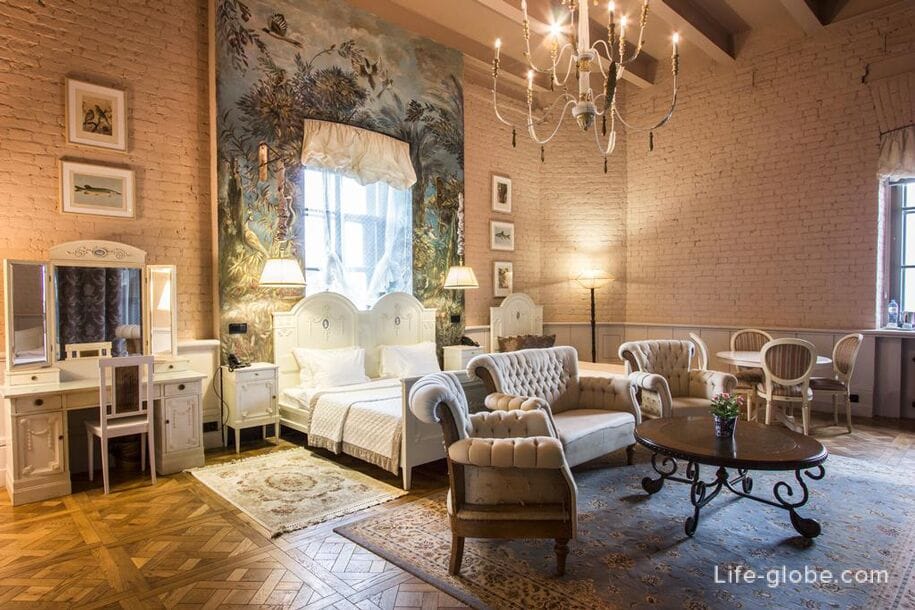
The 5-star luxury spa hotel "Tsar Palace Luxury Hotel & SPA"is located in a historic building.
The hotelfeatures a spa area with a swimming pool, a hammam, a salt sauna, a snow fountain, steam baths and a gym; free Wi-Fi, a 24-hour front desk, 2 restaurants, a lobby bar, private parking and meeting and conference rooms.
The rooms are equipped with climate control, a minibar, a safe and a private bathroom.
A buffet breakfast is included in the room rate. Link to the hotel
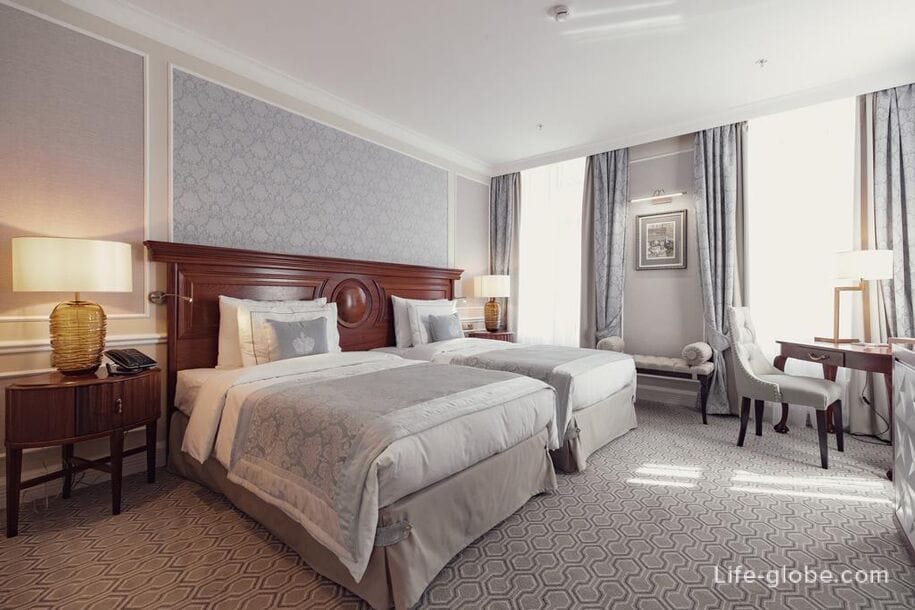
3-star hotel Ekaterina, located on the territory of the Catherine Palace and Park Ensemble.
At the hotel: 24-hour front desk, cafe, free Wi-Fi and parking.
Each room here will provide you with air conditioning, a TV, a work desk and free toiletries.
Breakfast is included in the room rate. Link to the hotel
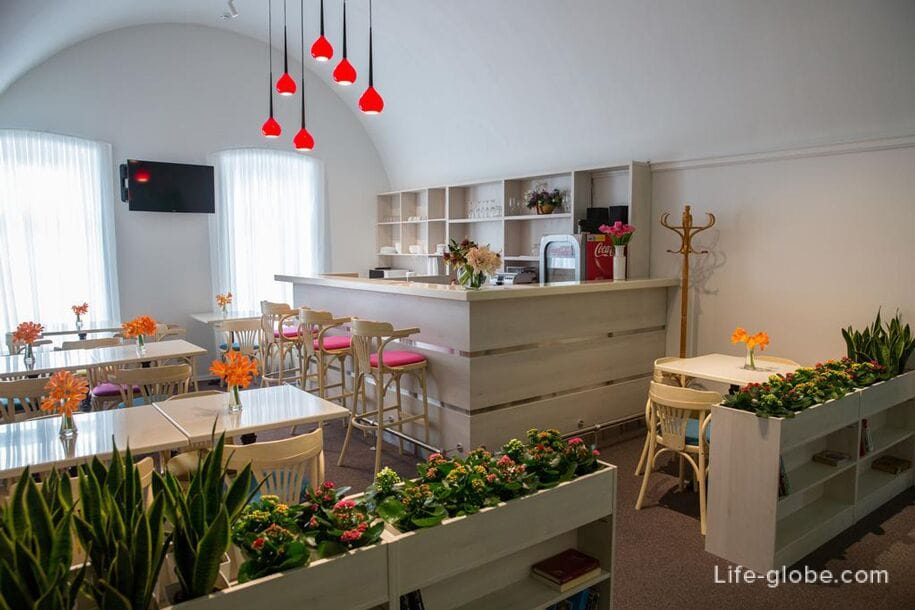
All accommodation facilities in St. Petersburg, including in the city center and in Pushkin, can be viewed and booked here






